
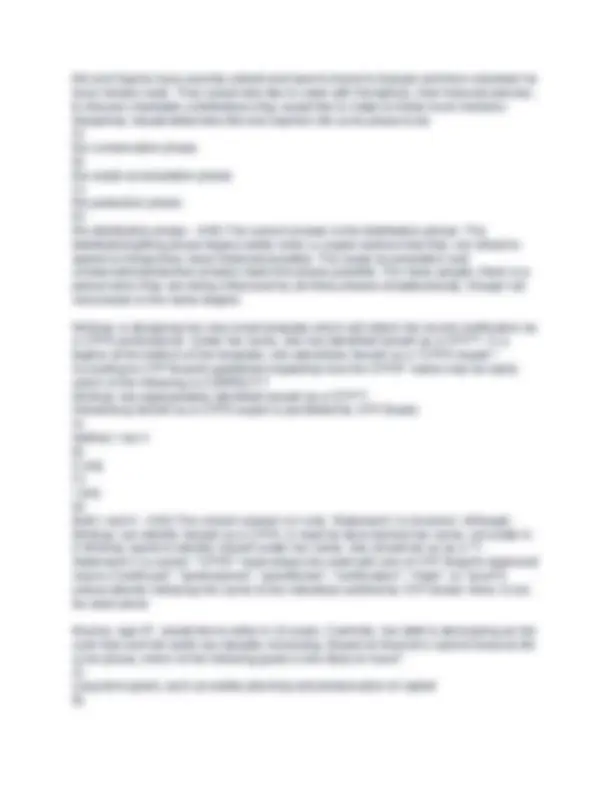
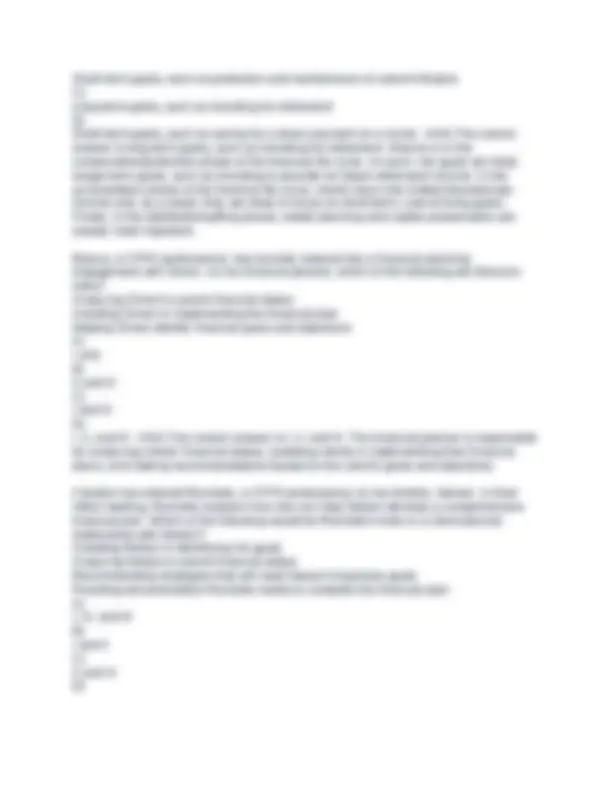
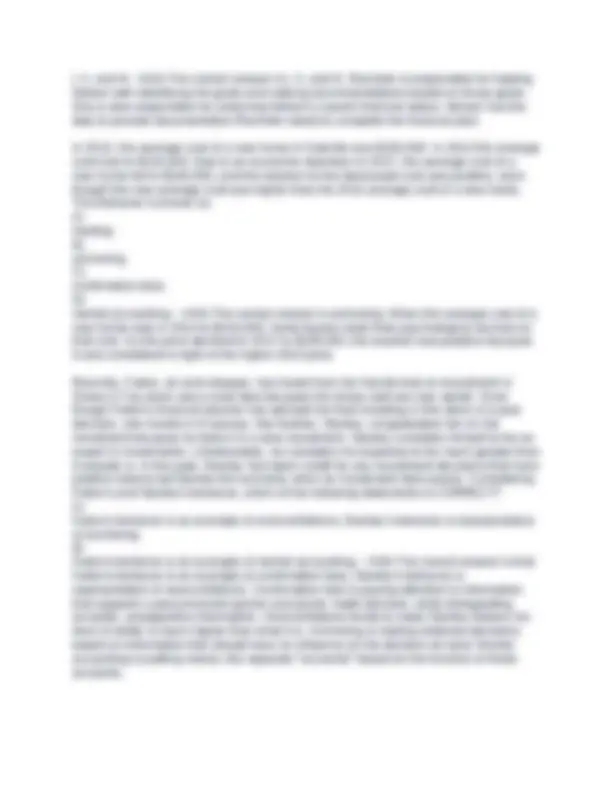
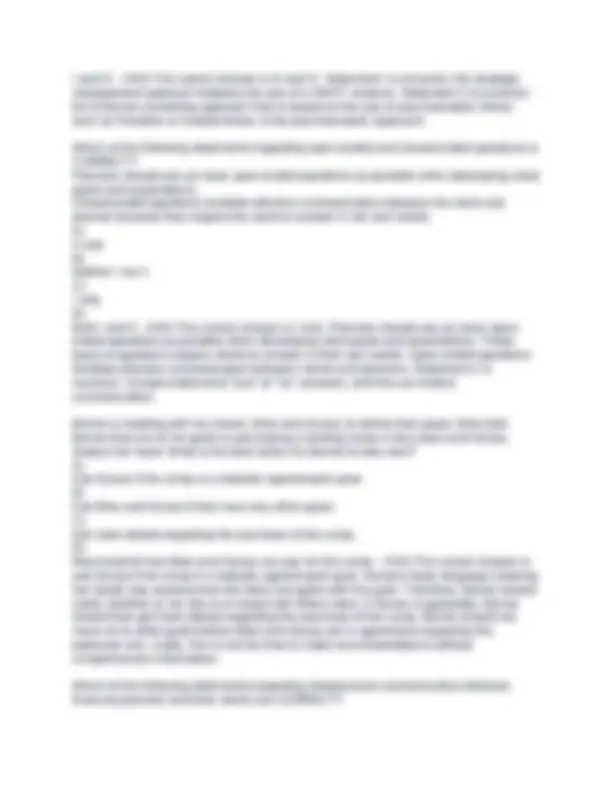

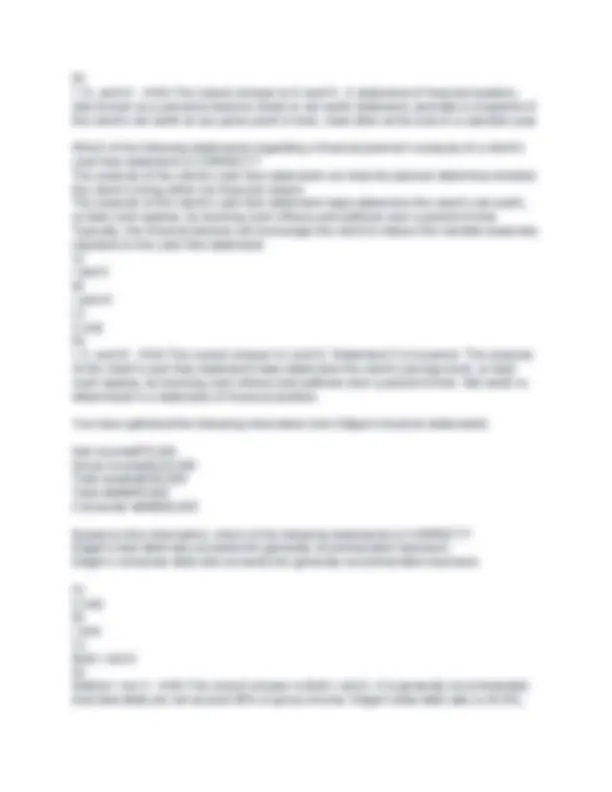
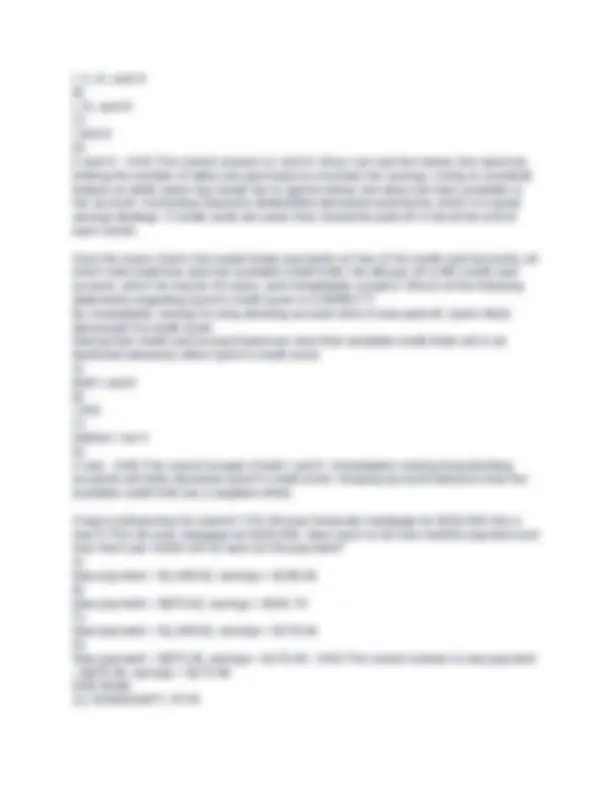

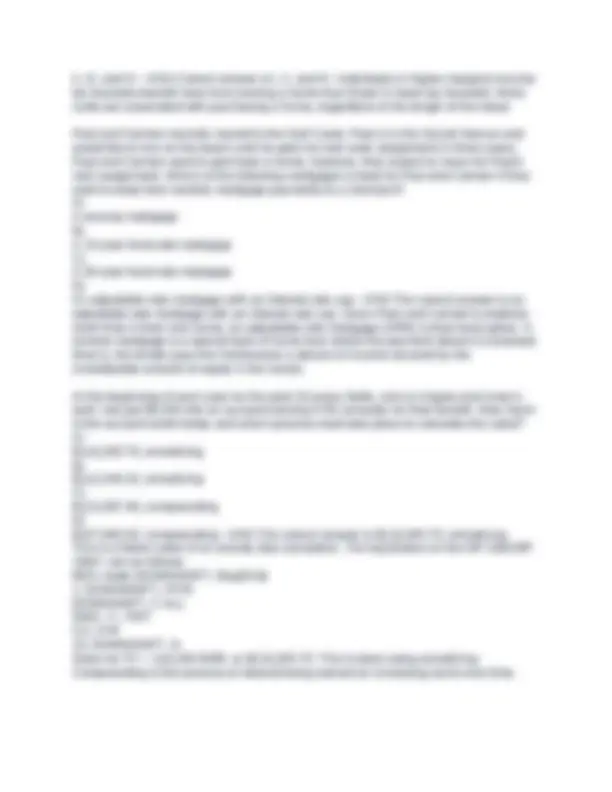
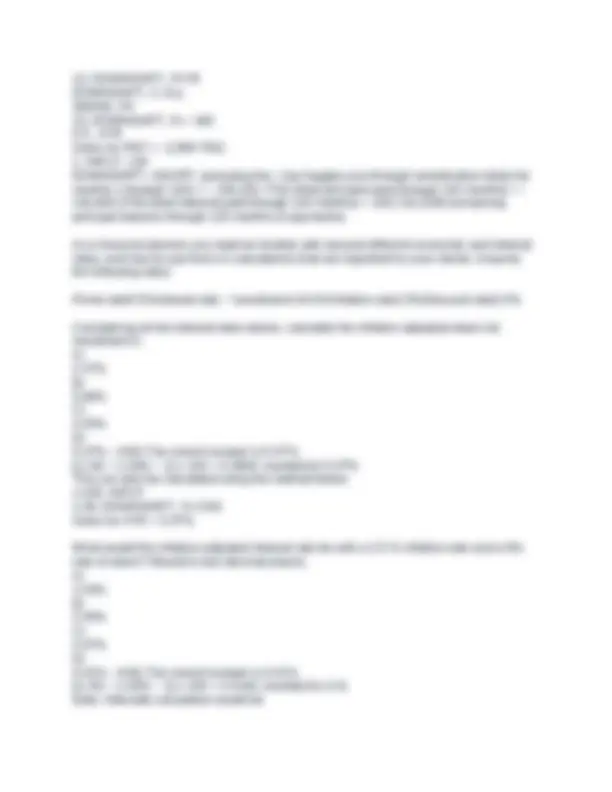
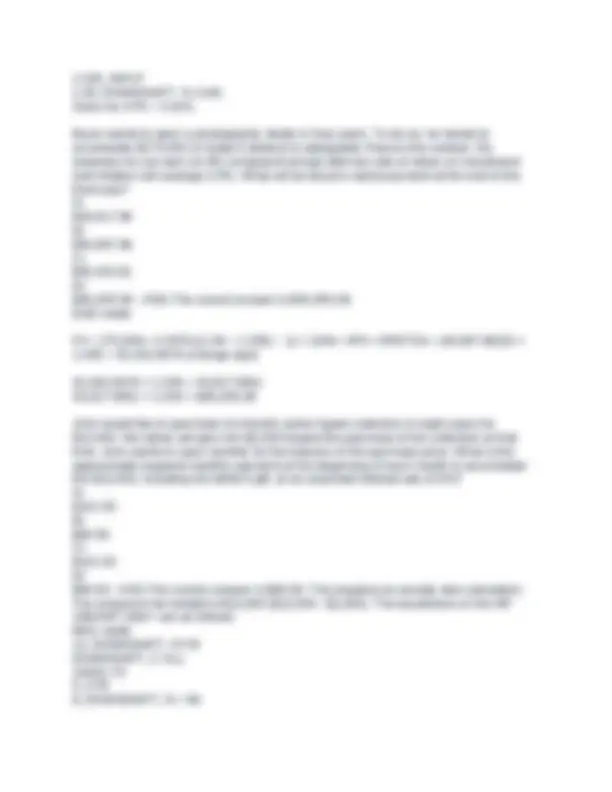

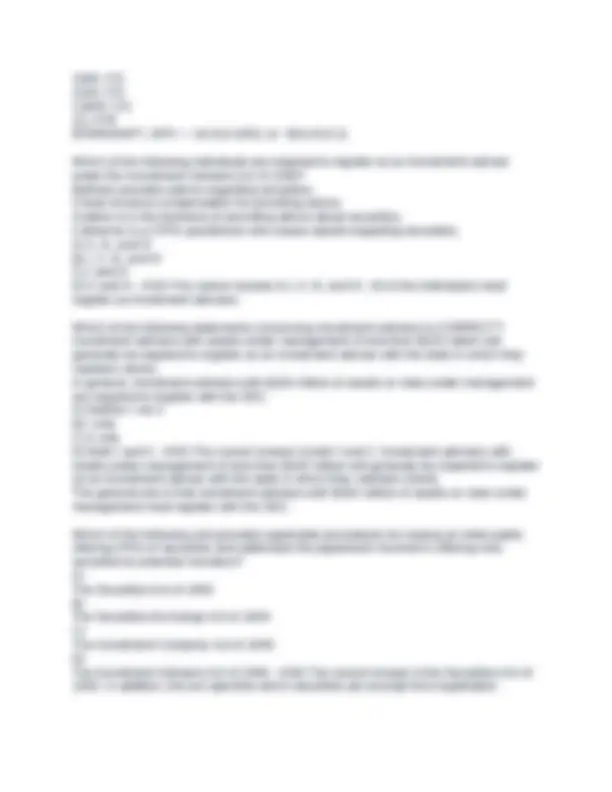
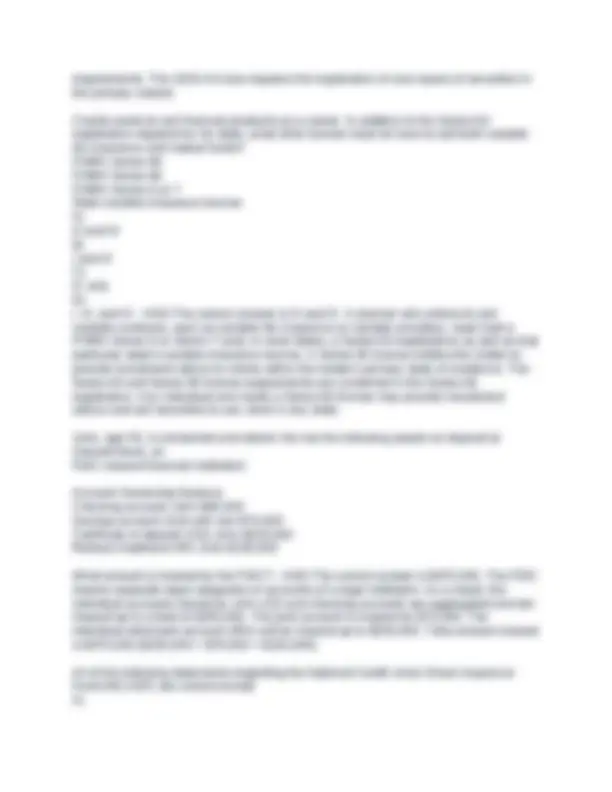



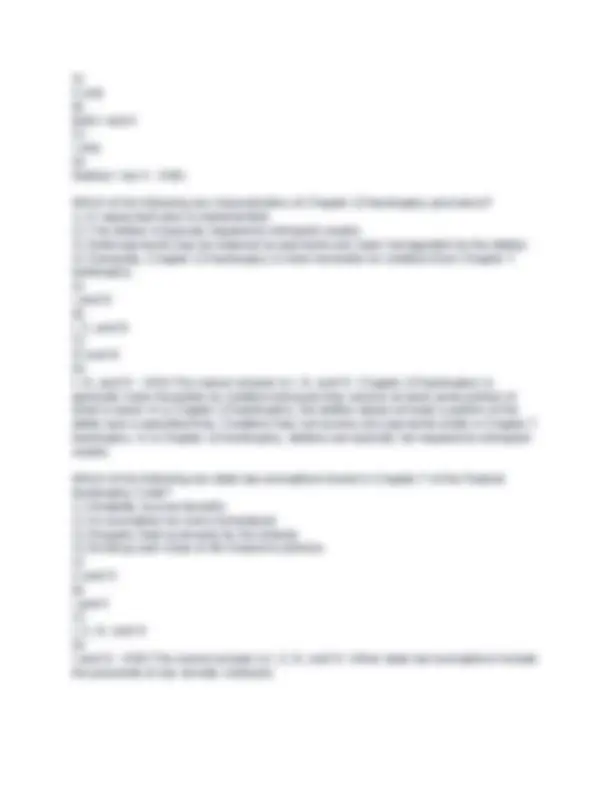
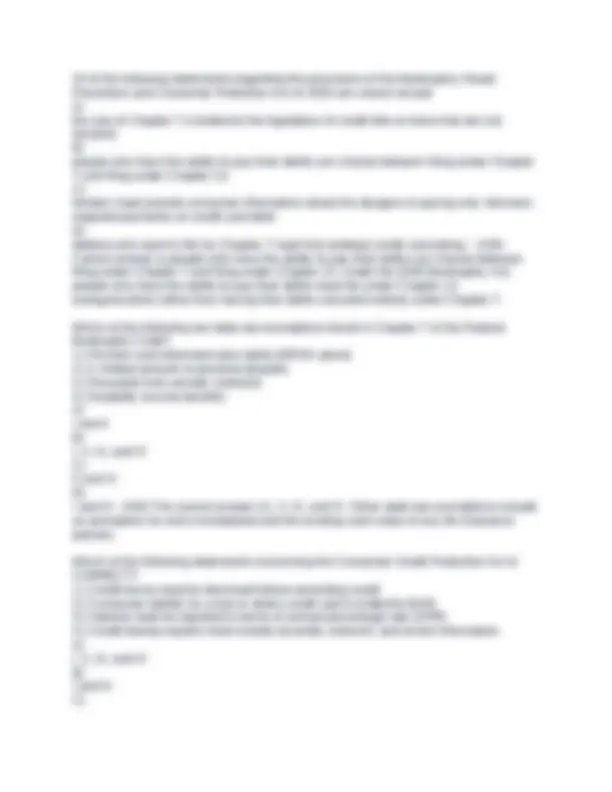
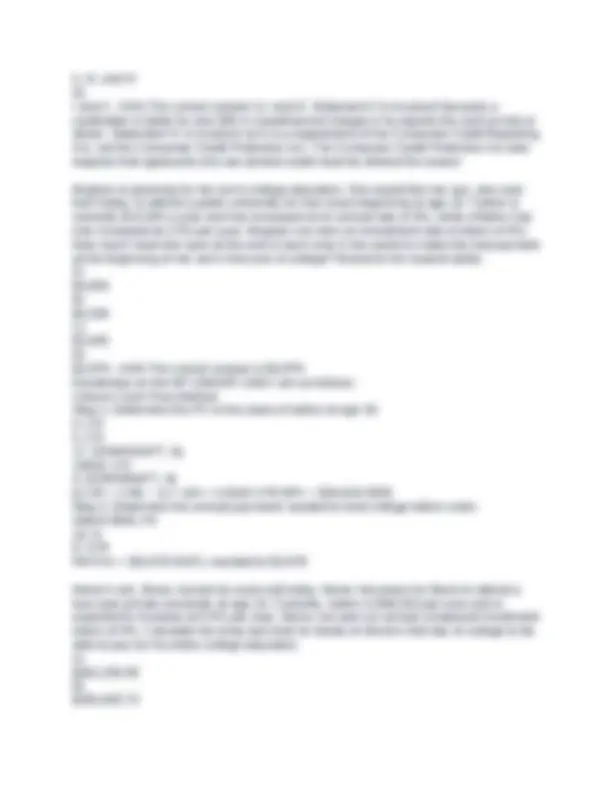
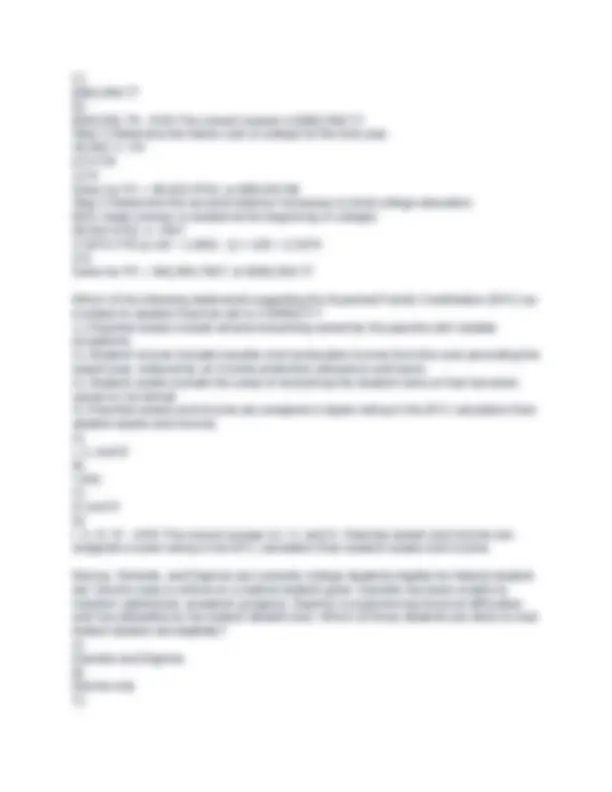
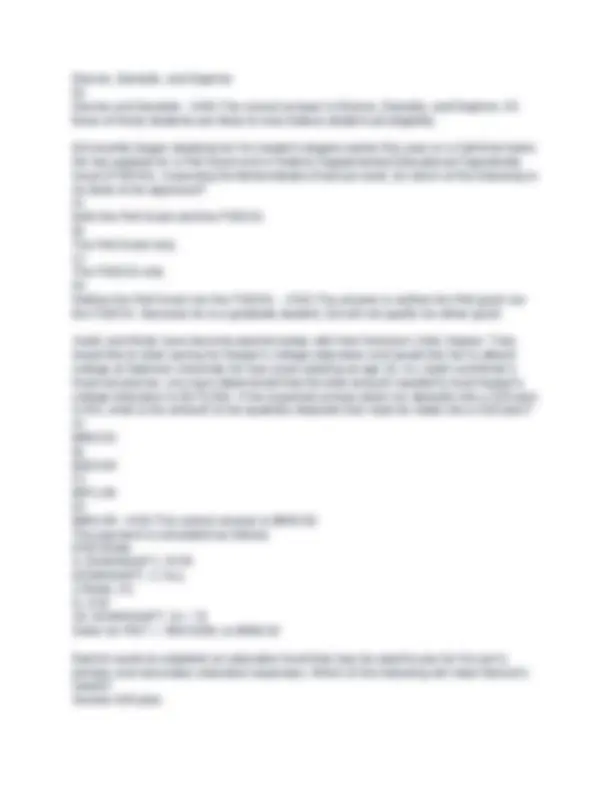
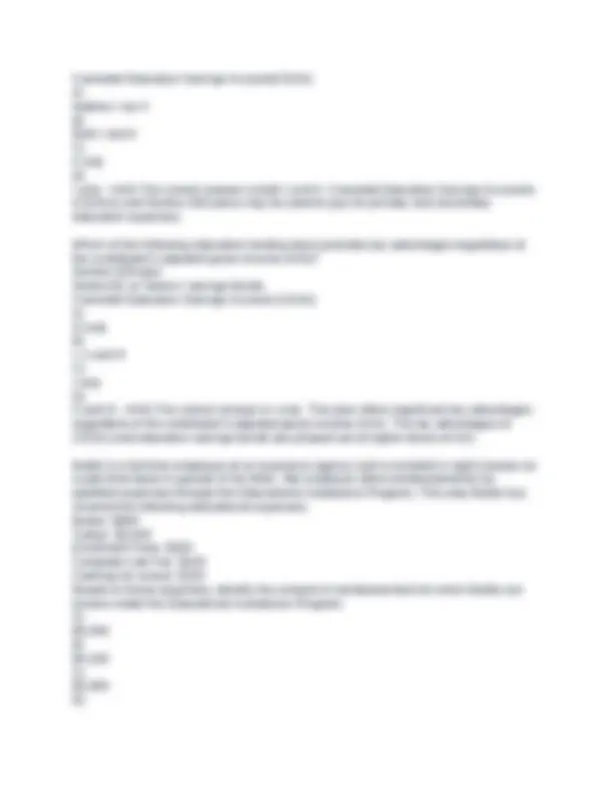
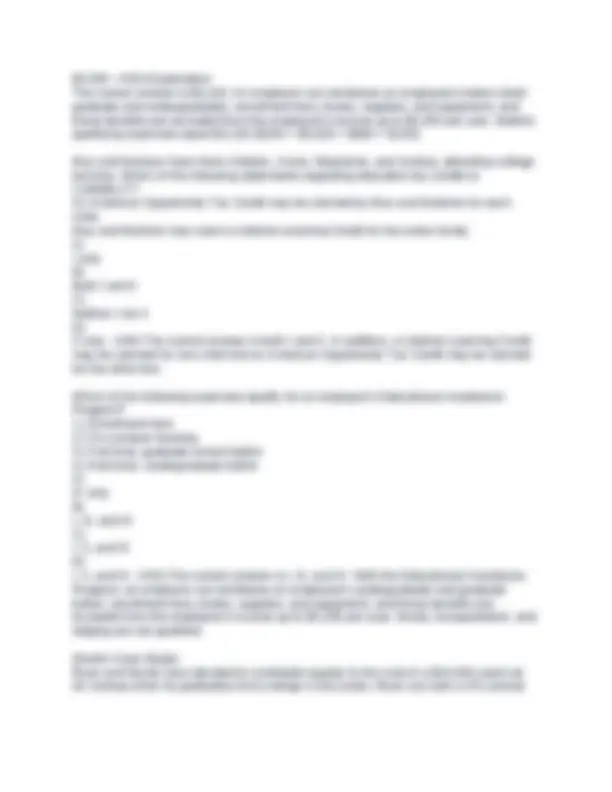

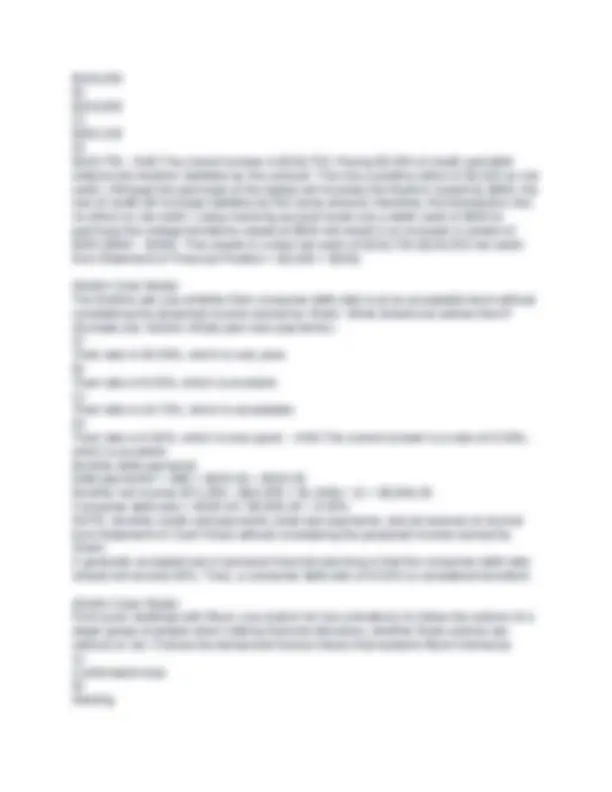
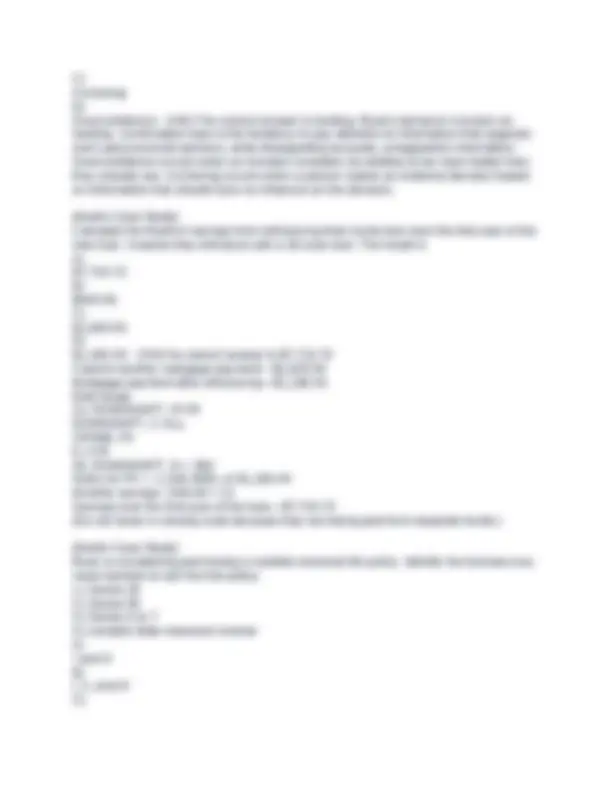
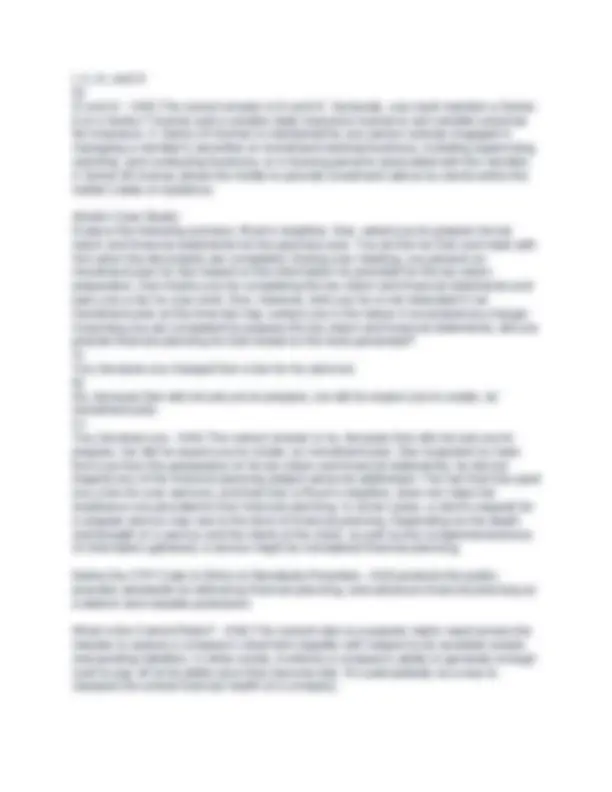
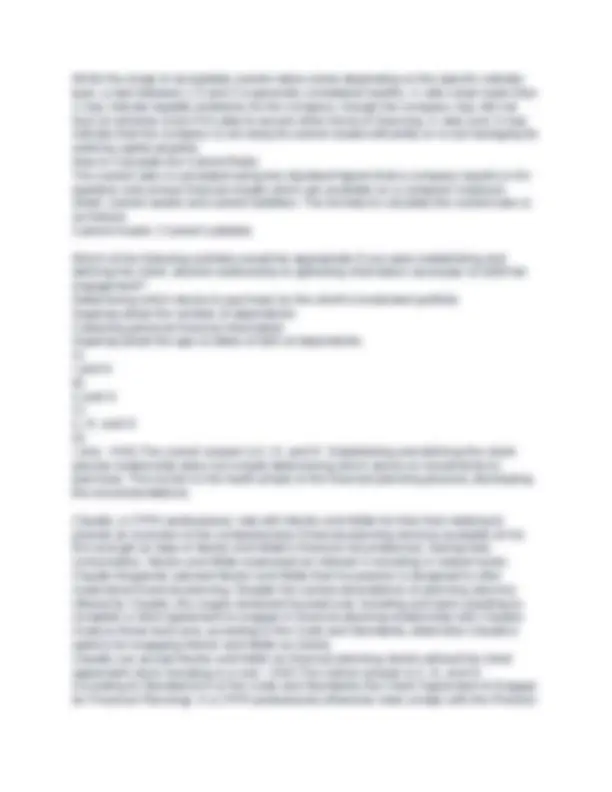
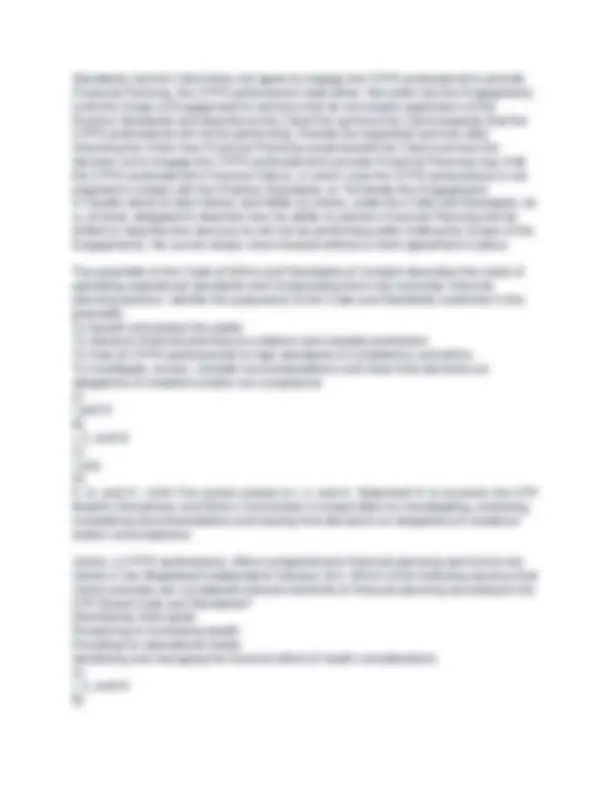

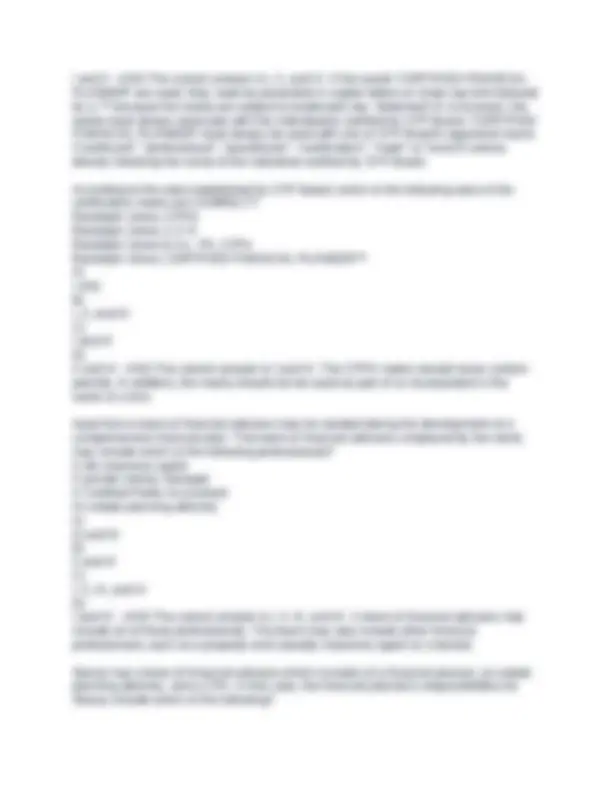
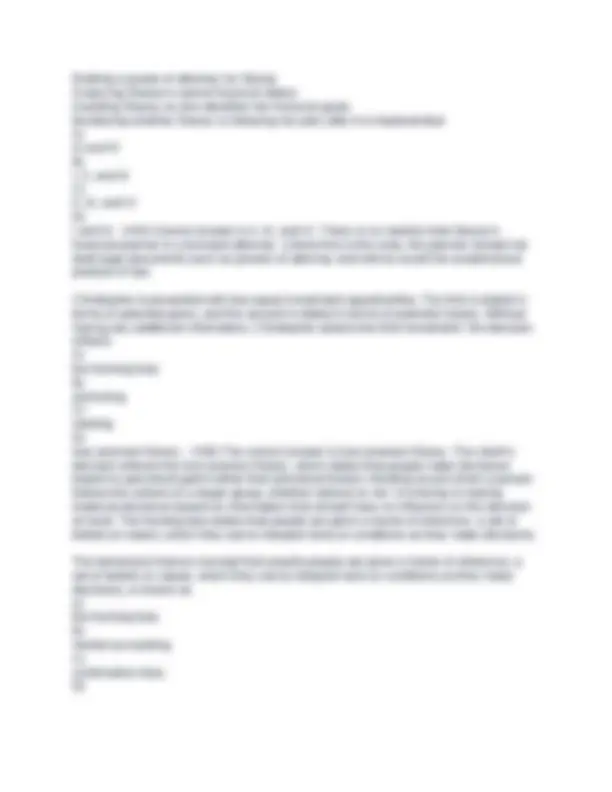
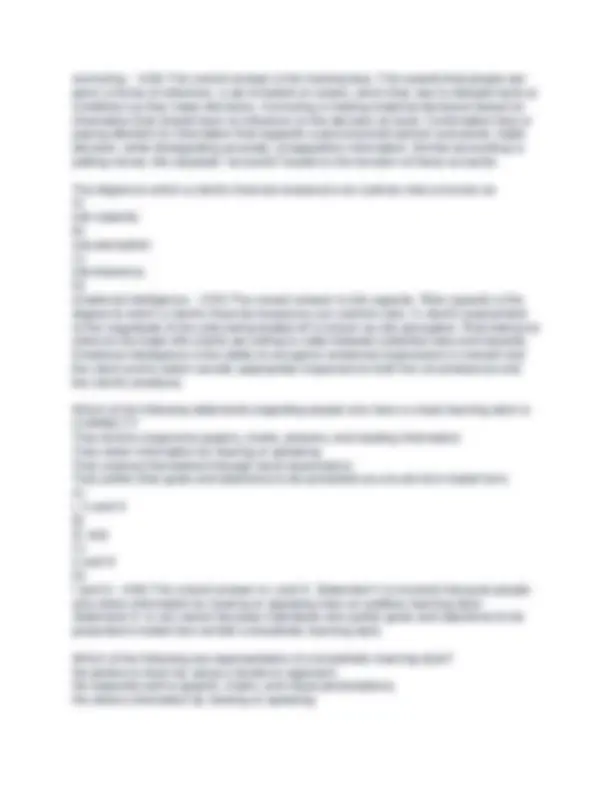
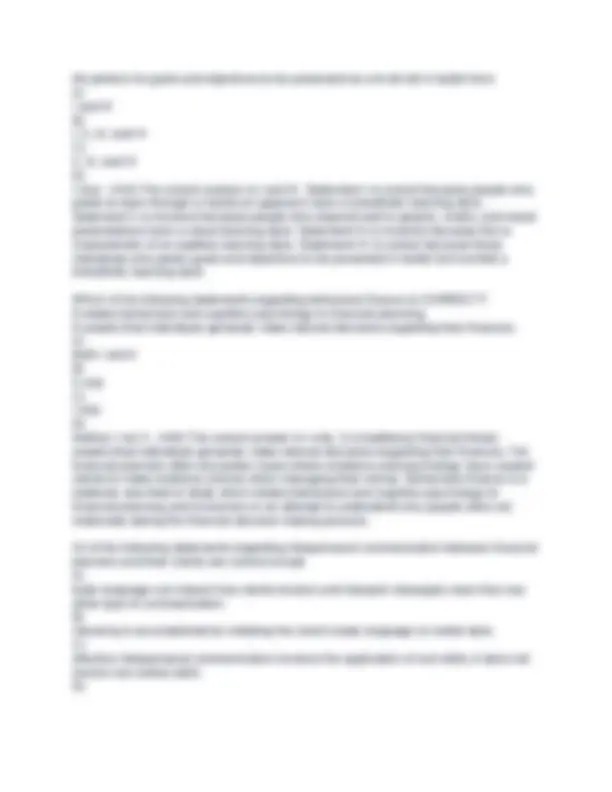
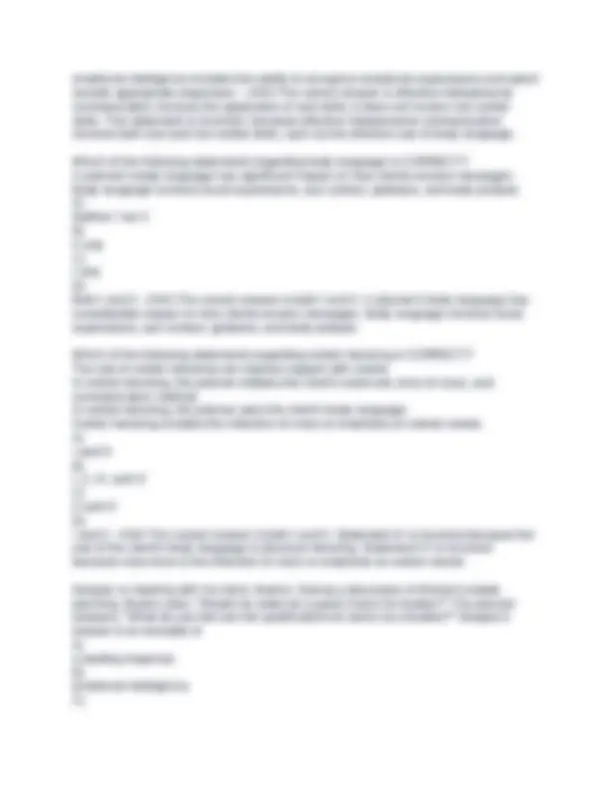
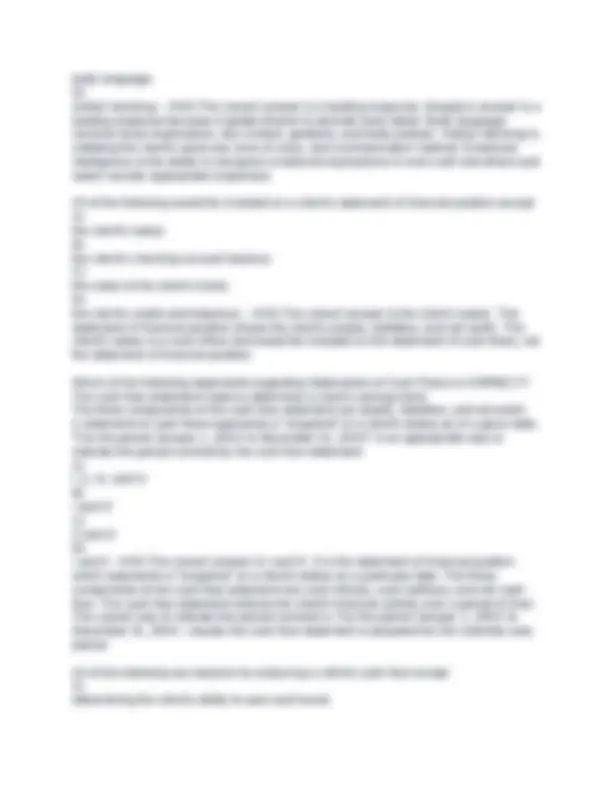
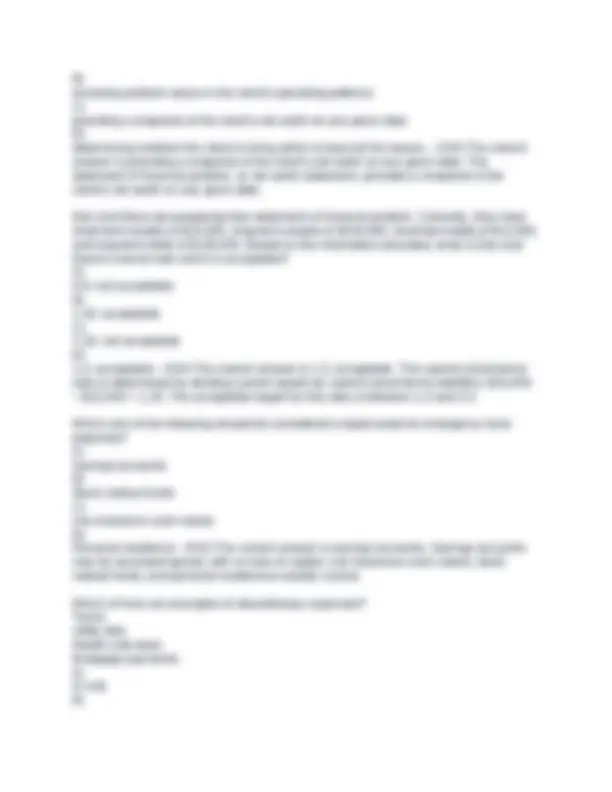
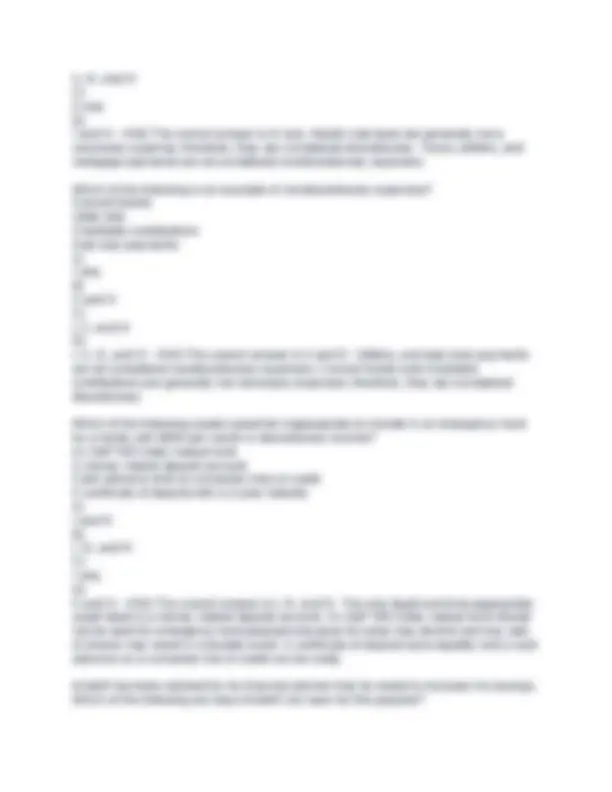
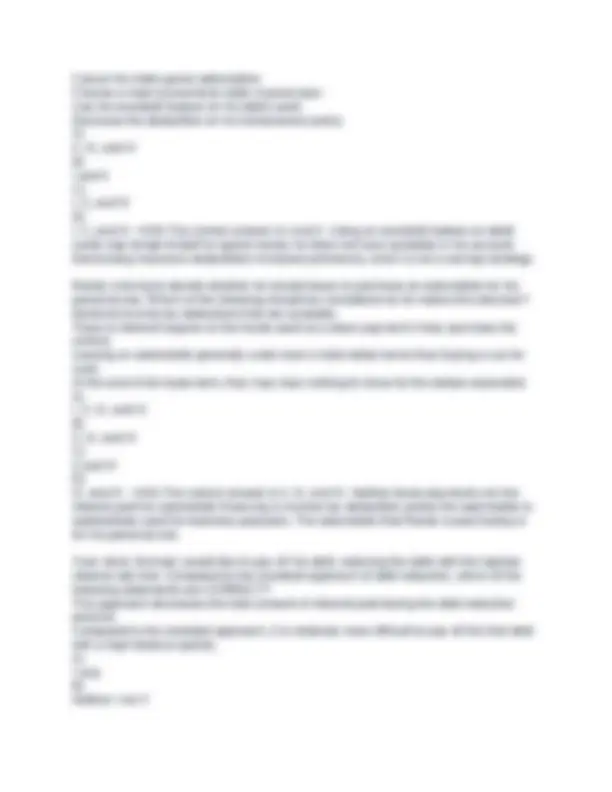
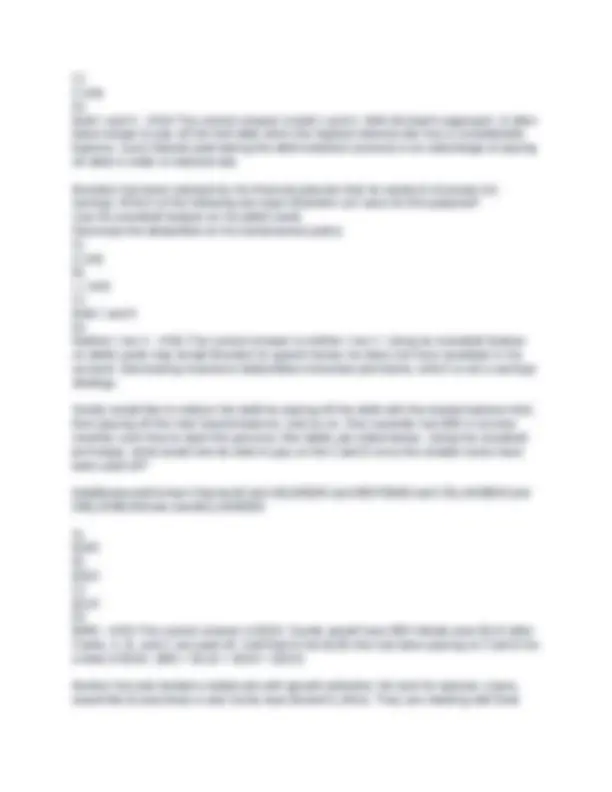
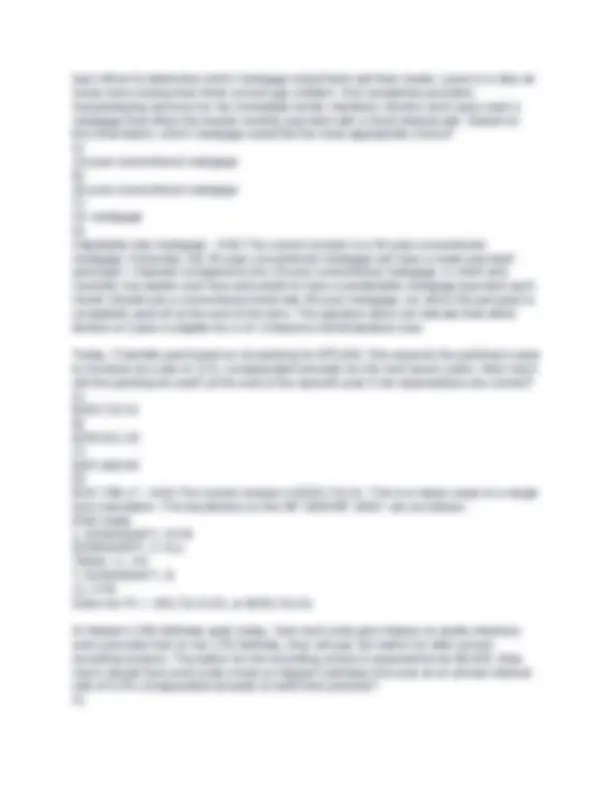
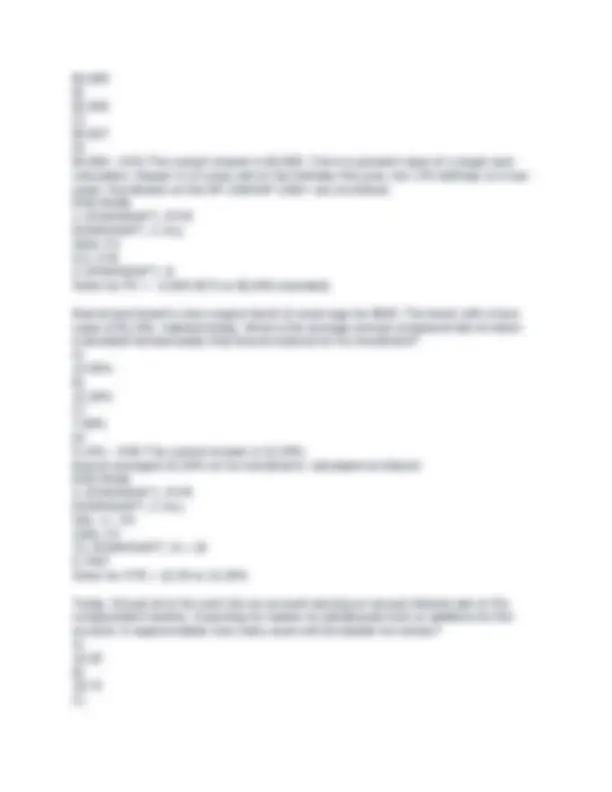


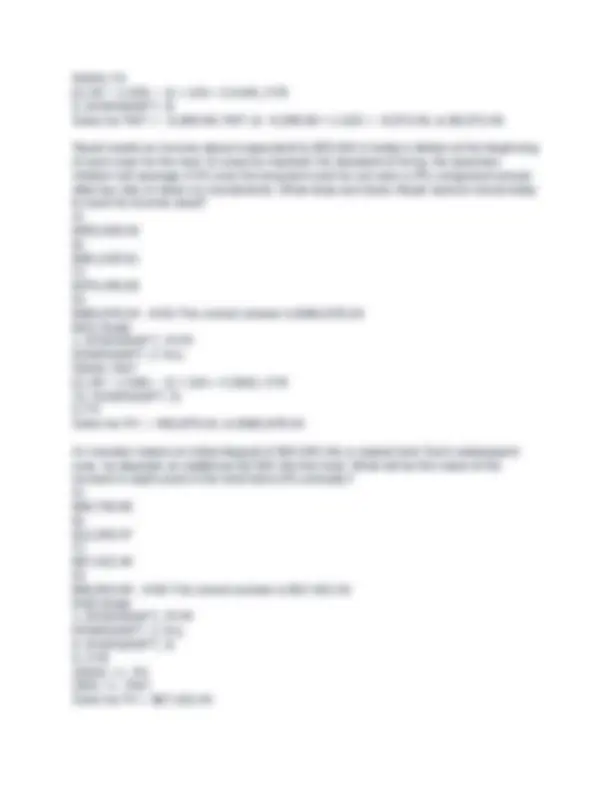
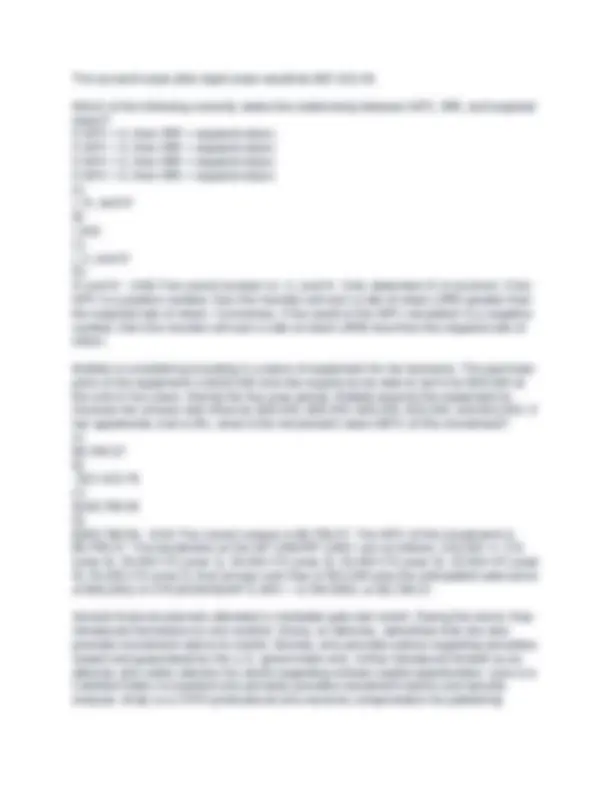
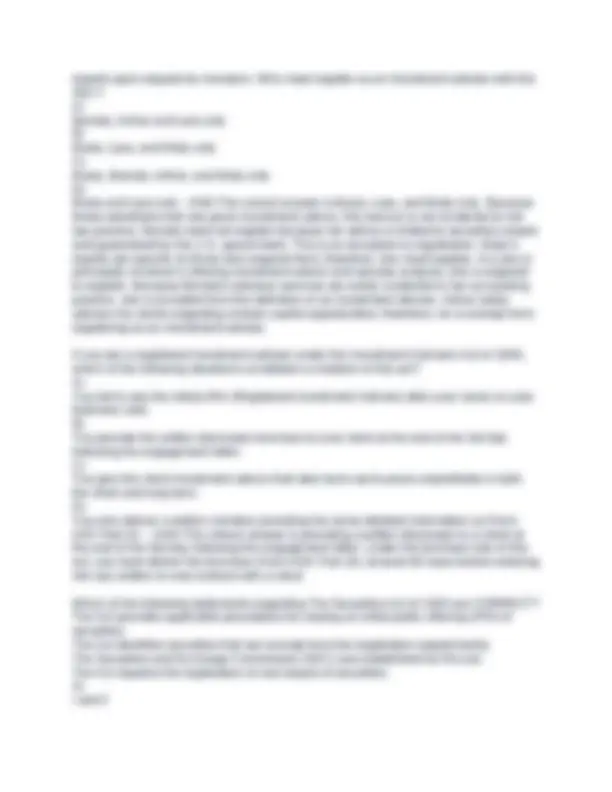
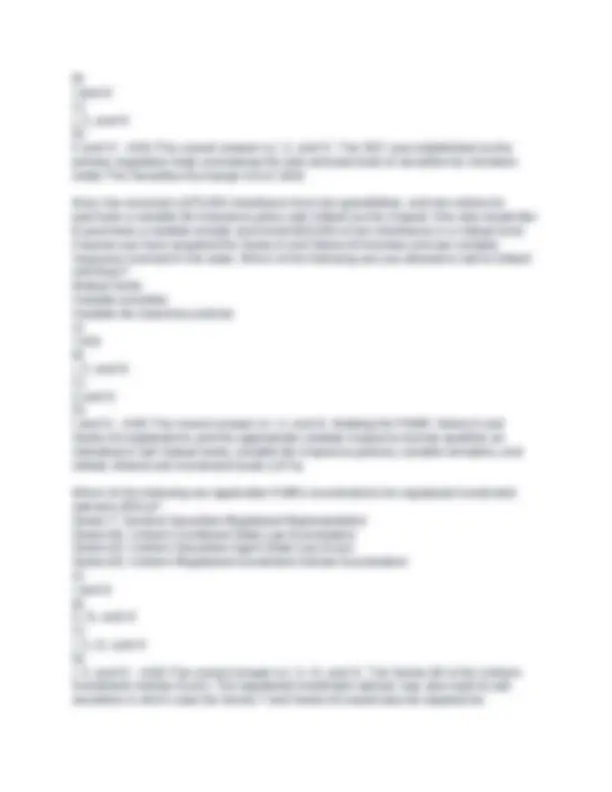
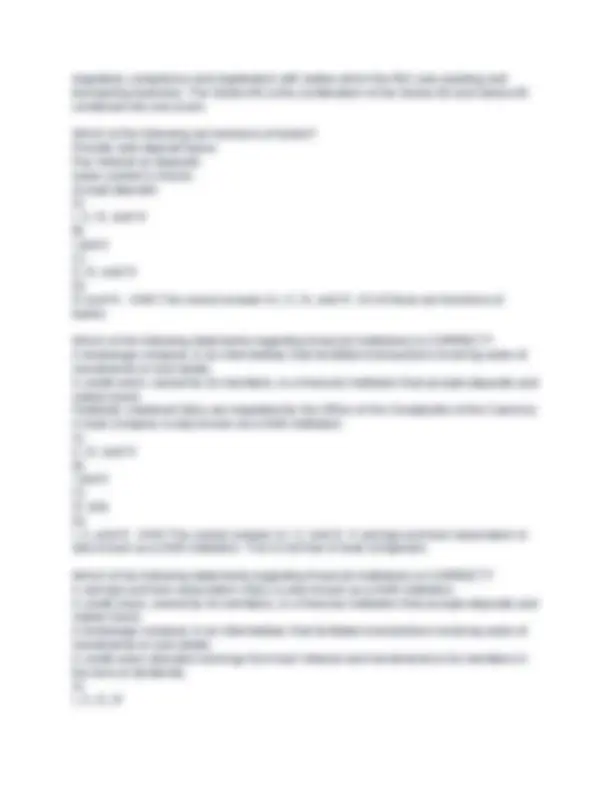
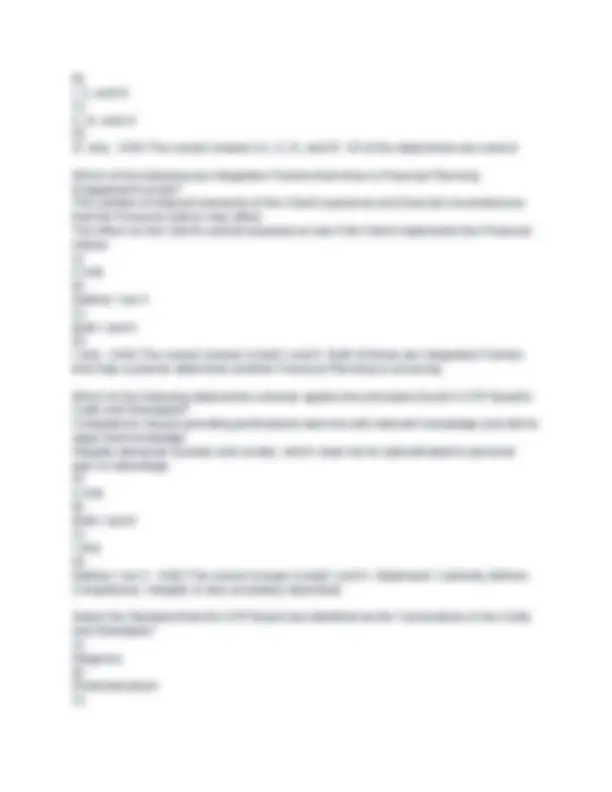
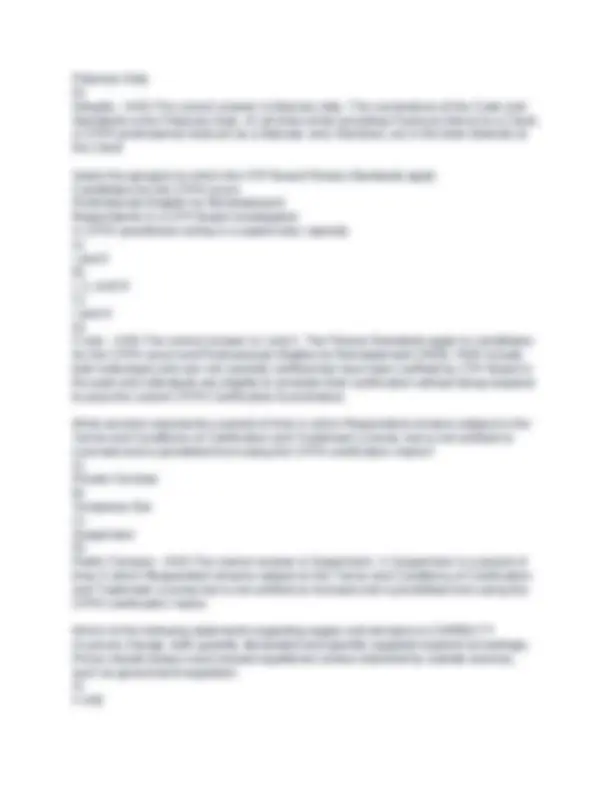
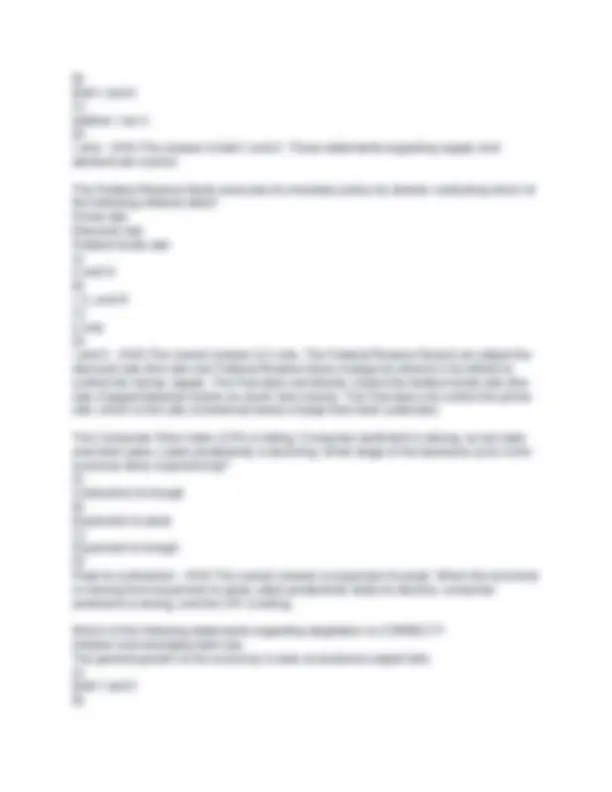

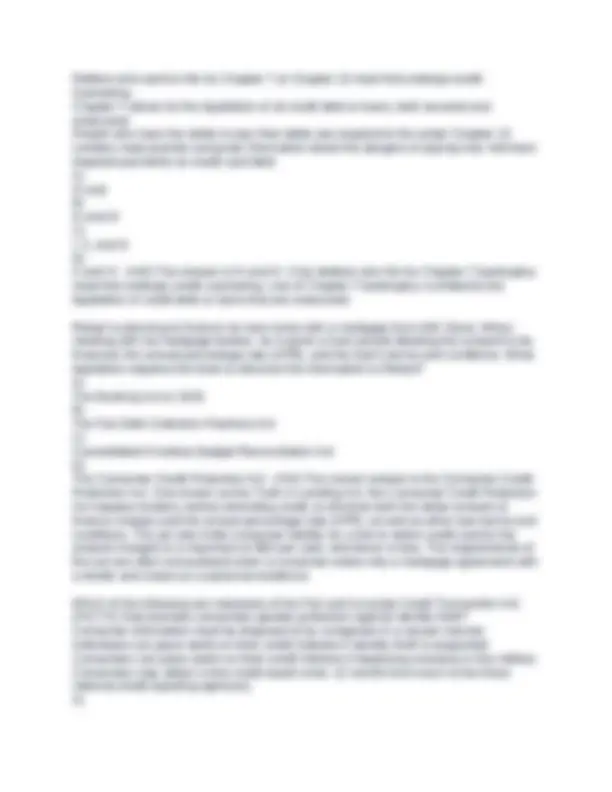
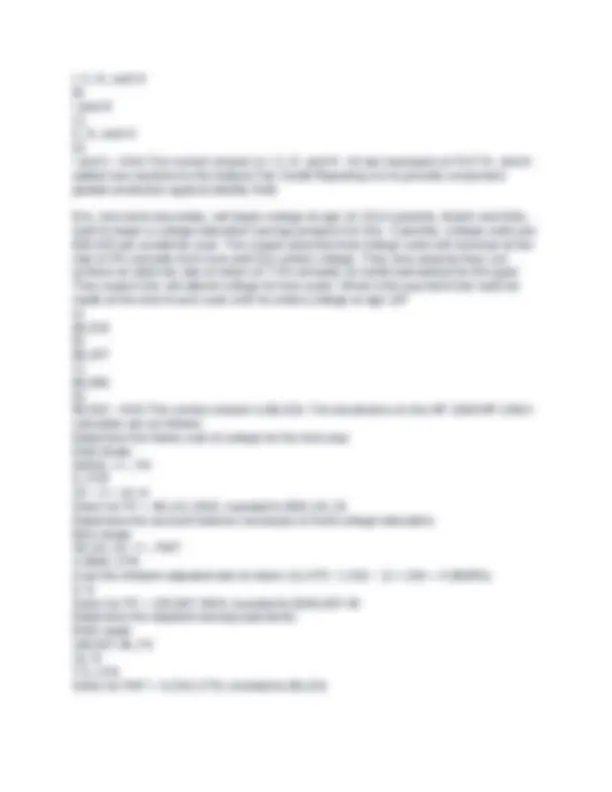

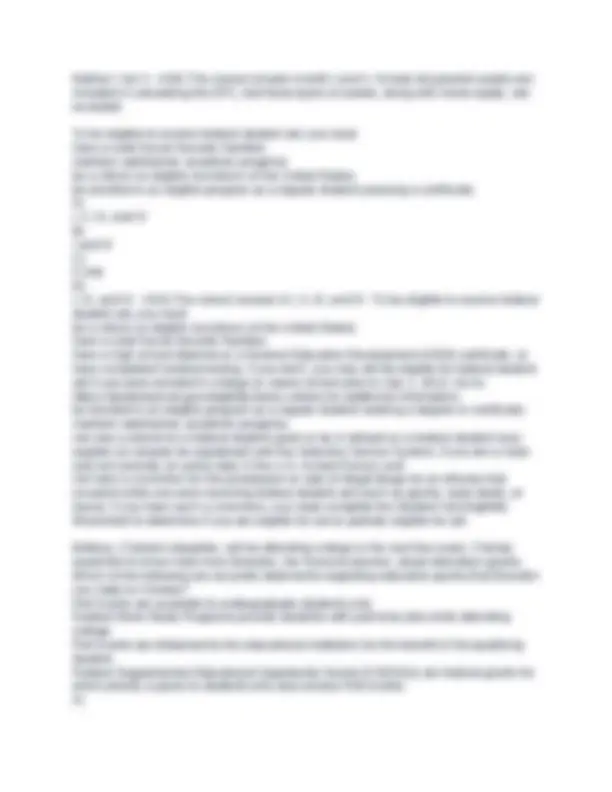

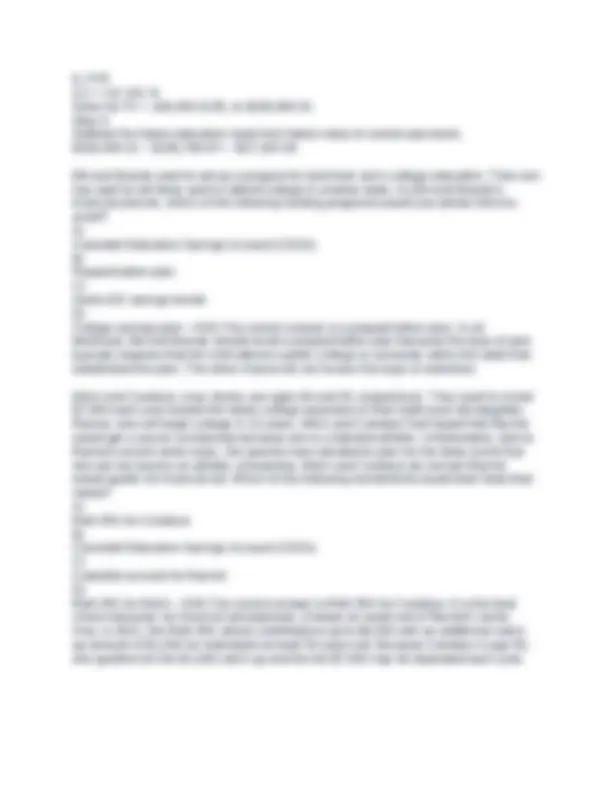
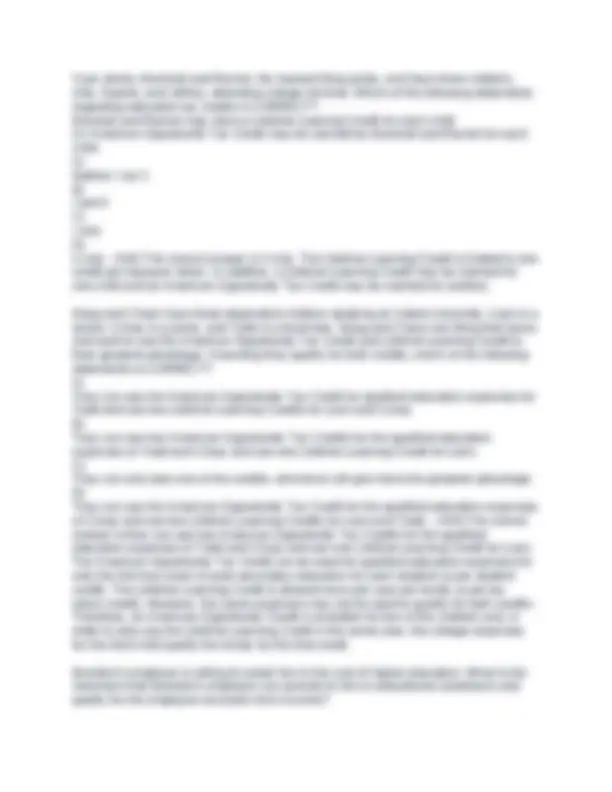
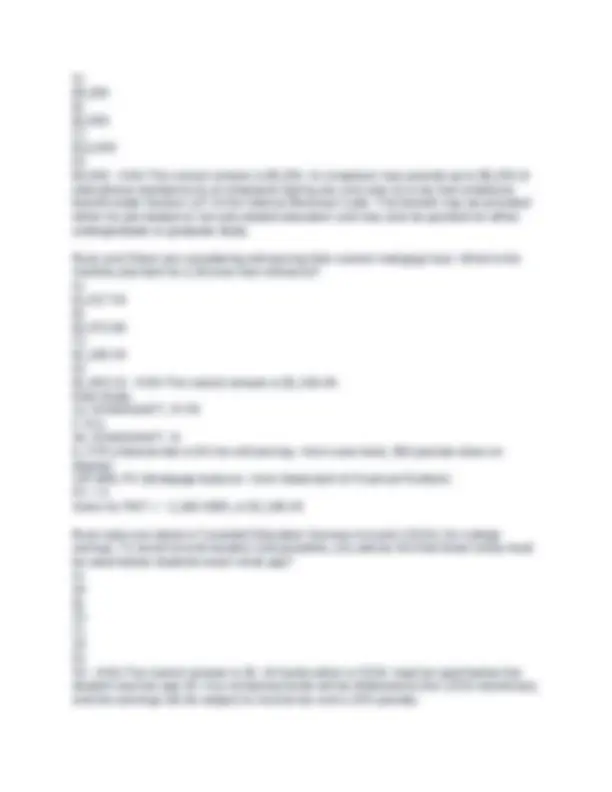
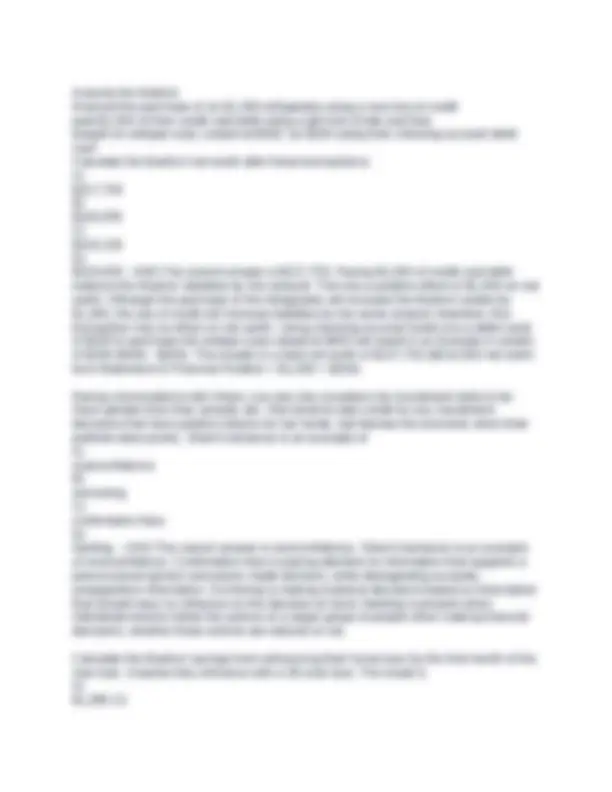
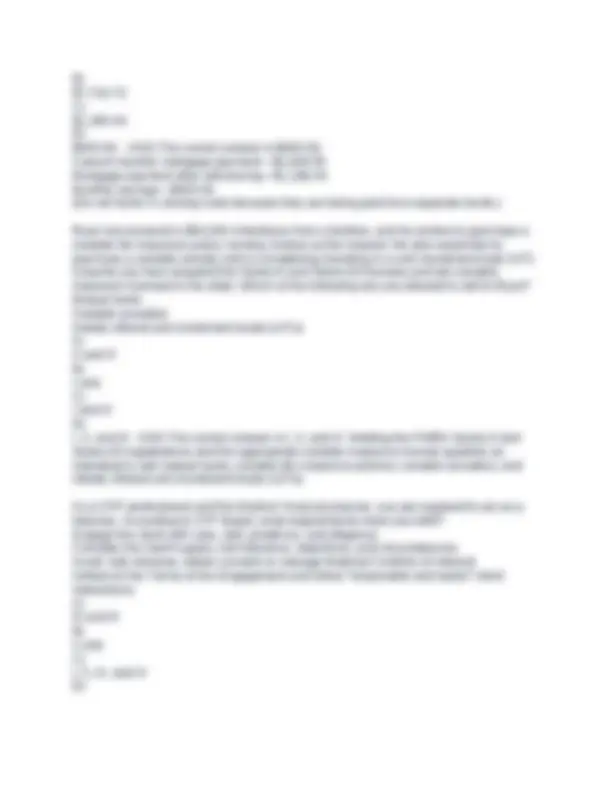
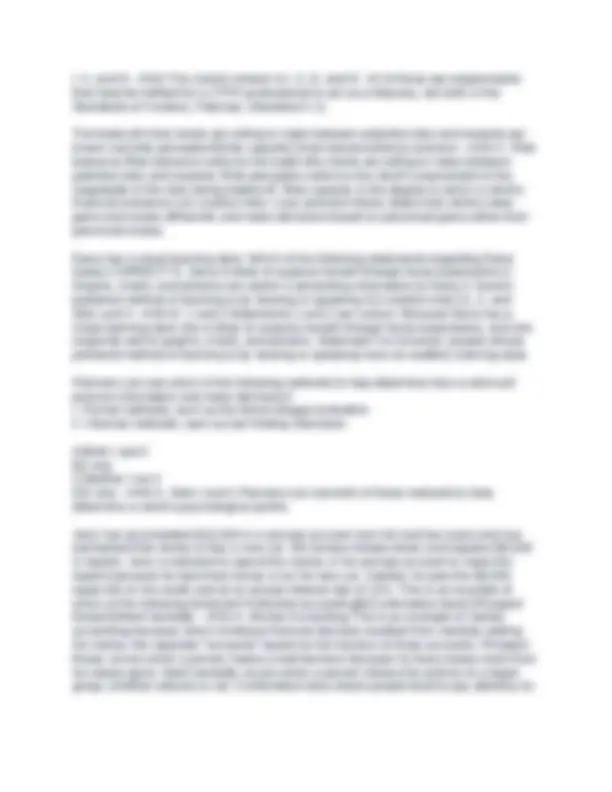
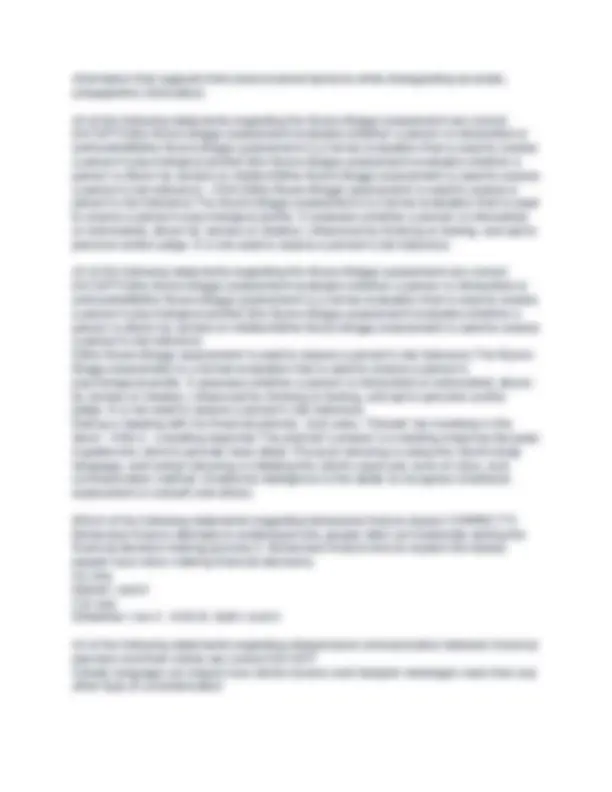
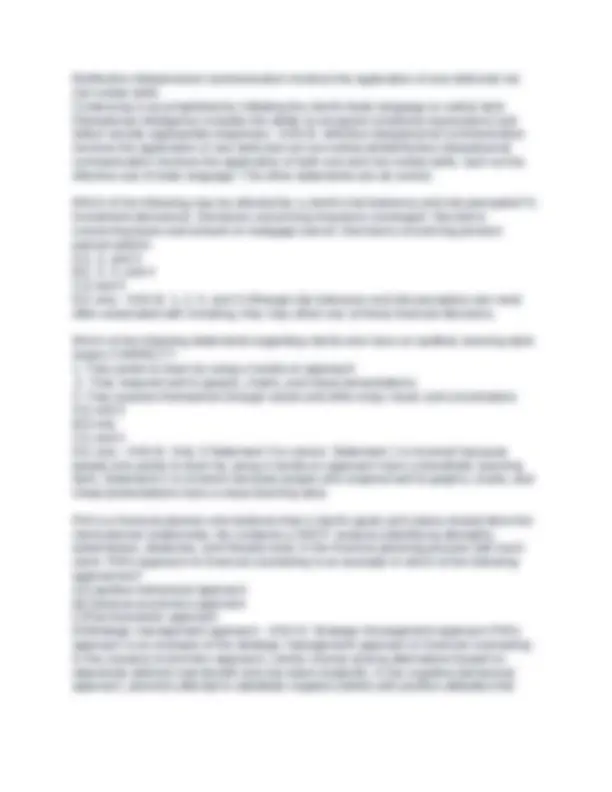
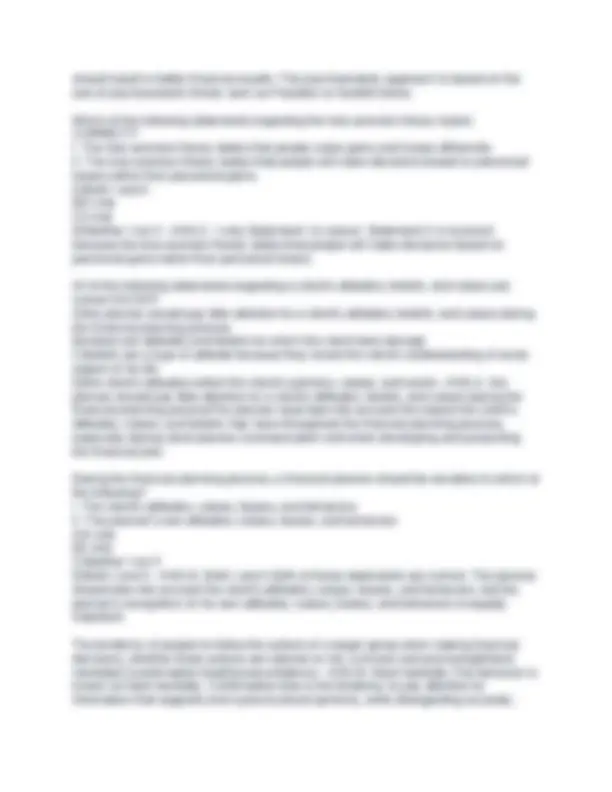
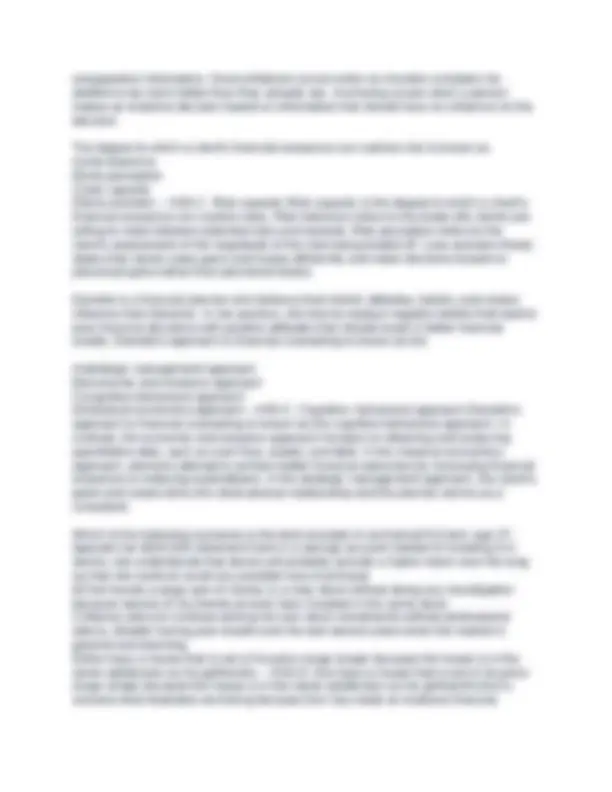
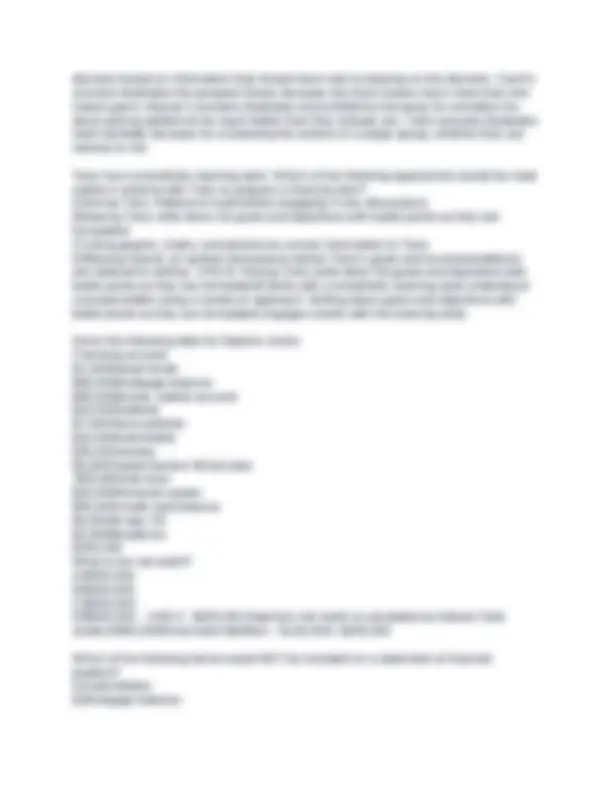
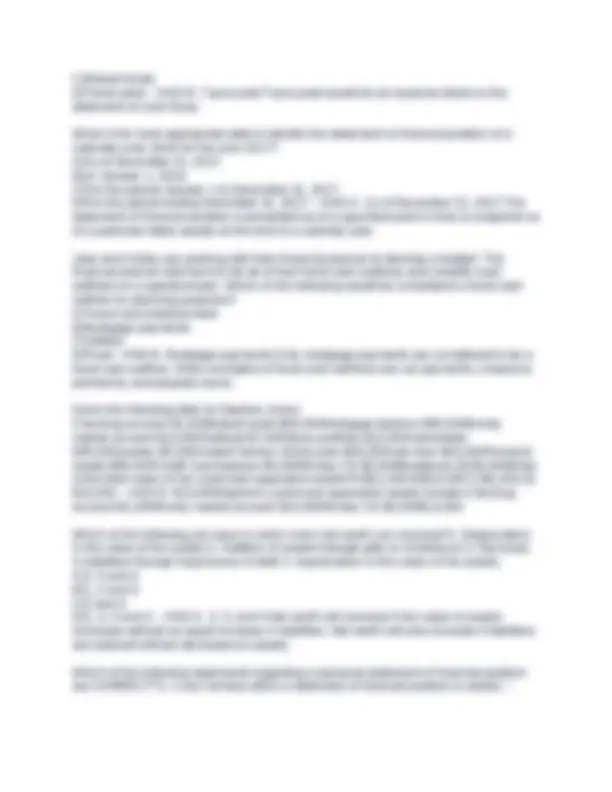
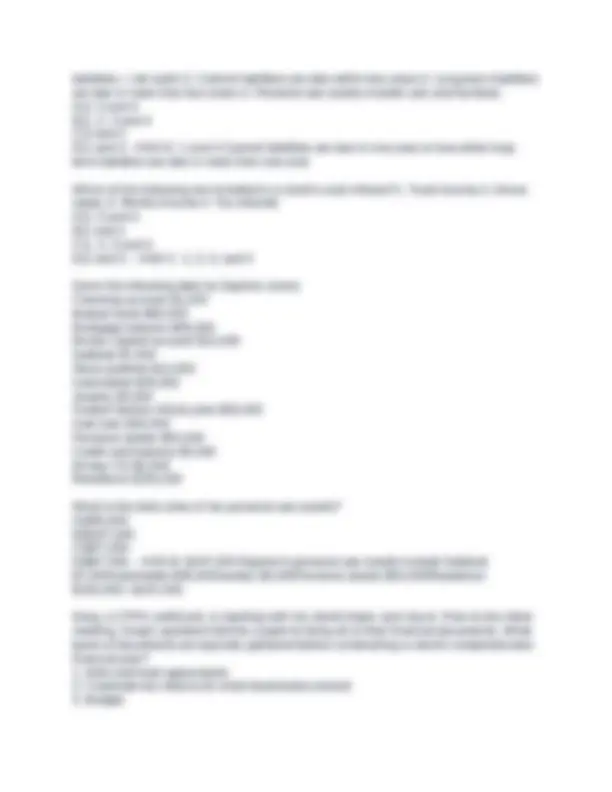
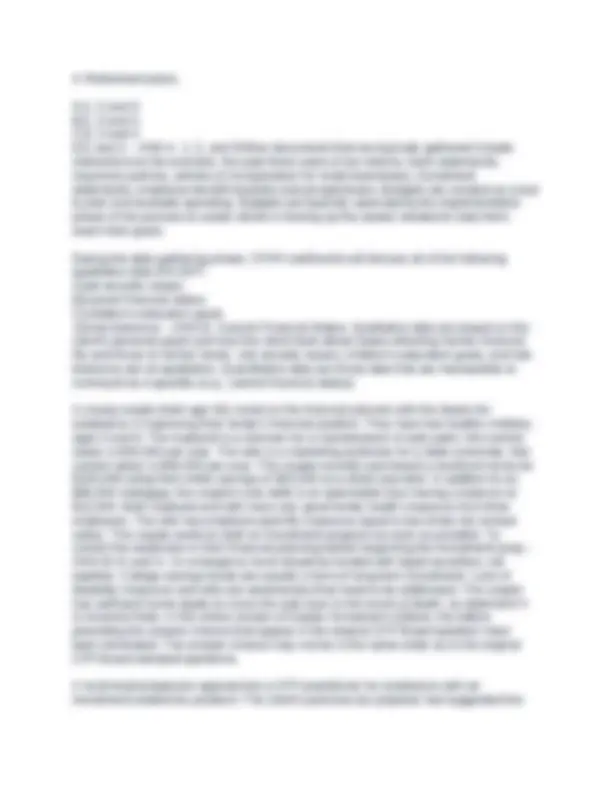
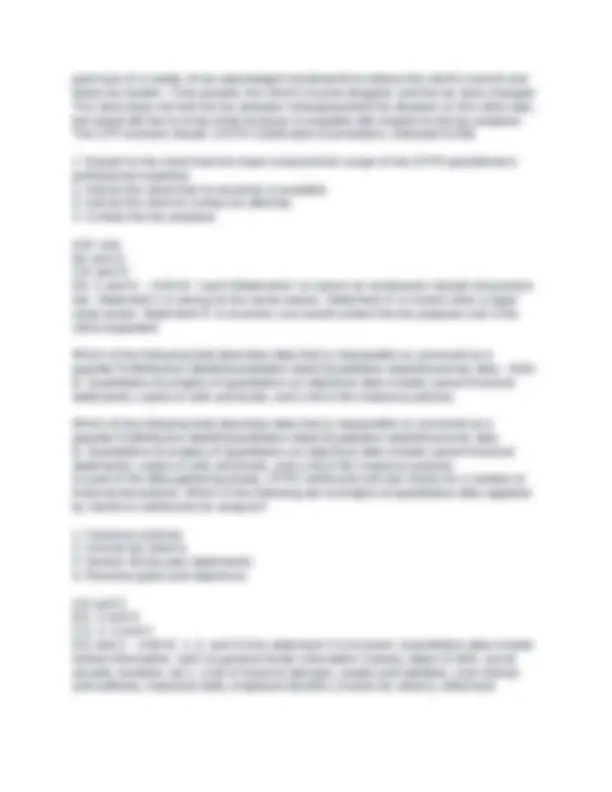
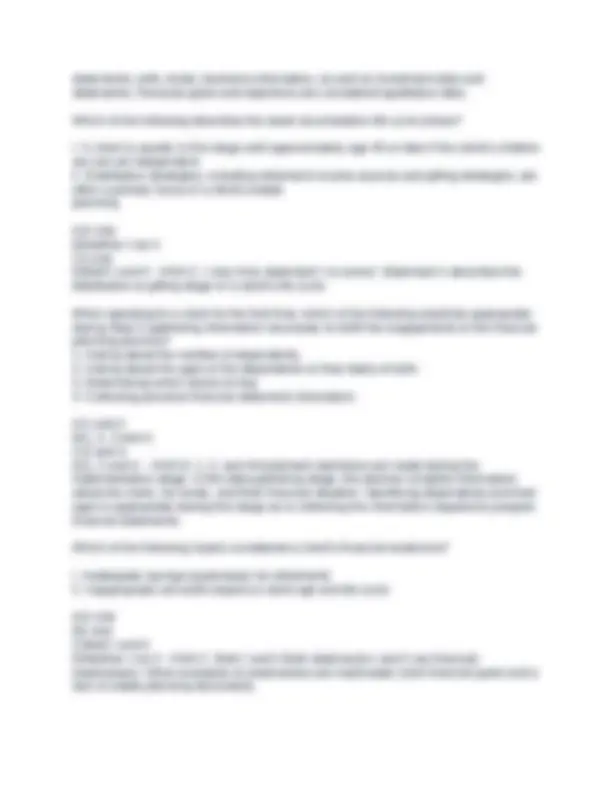
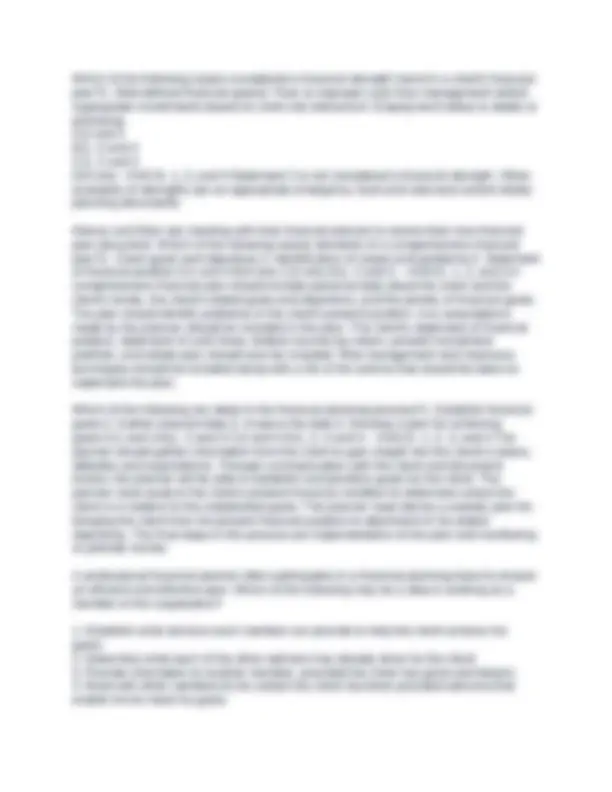
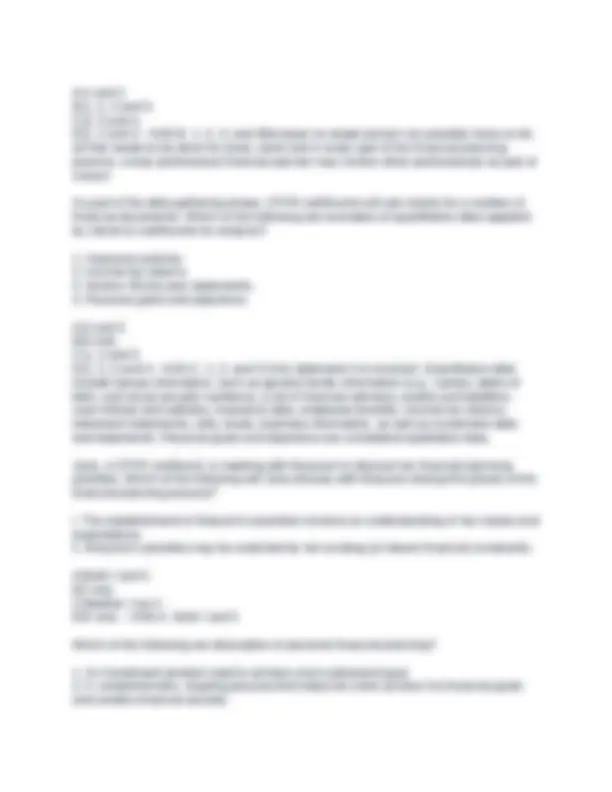
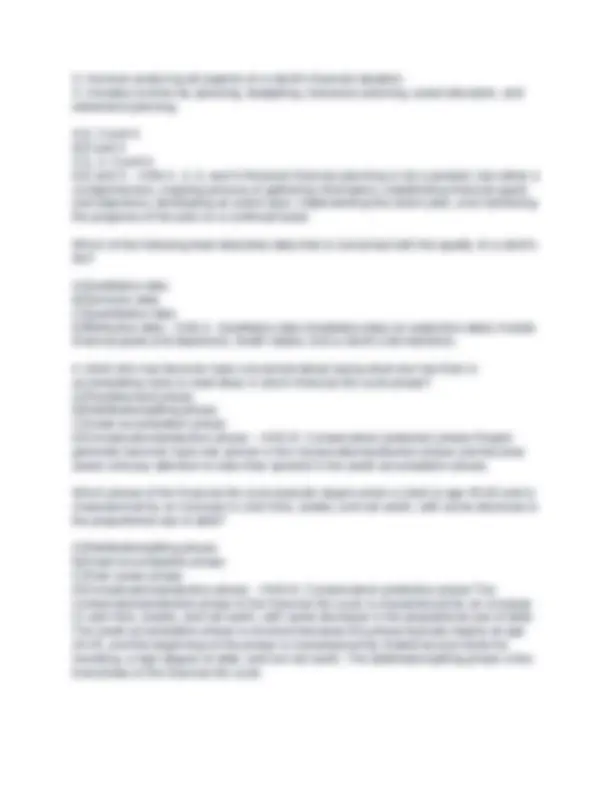
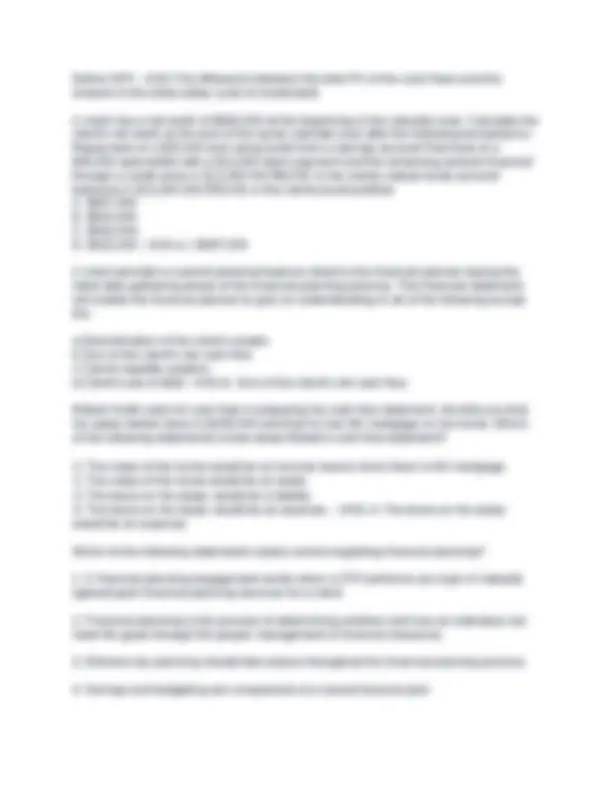
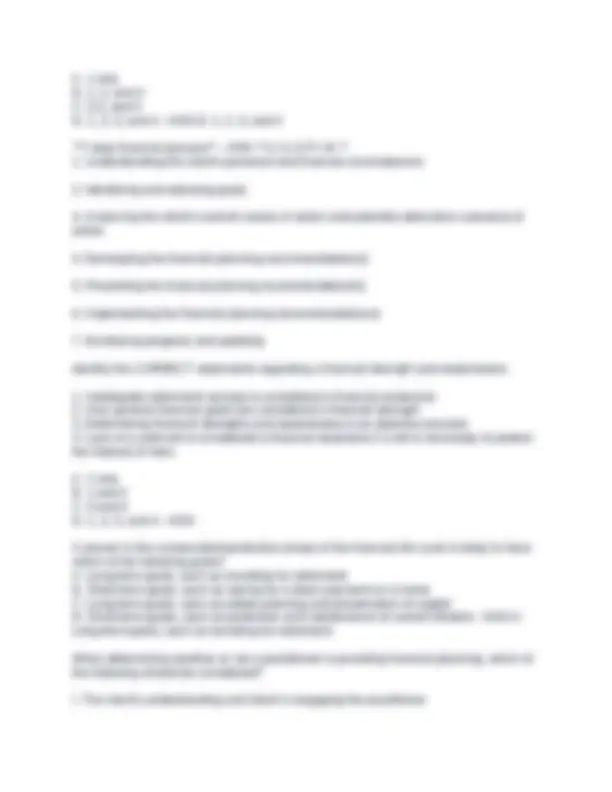
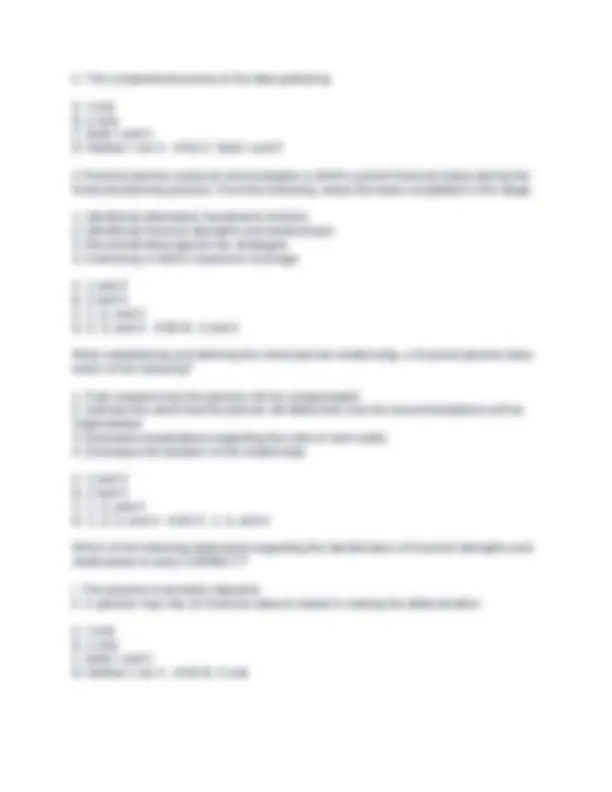
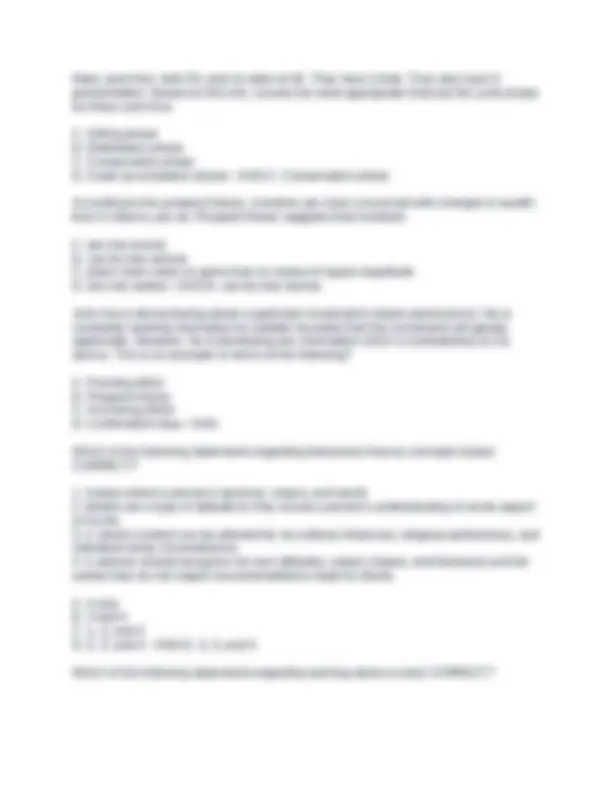

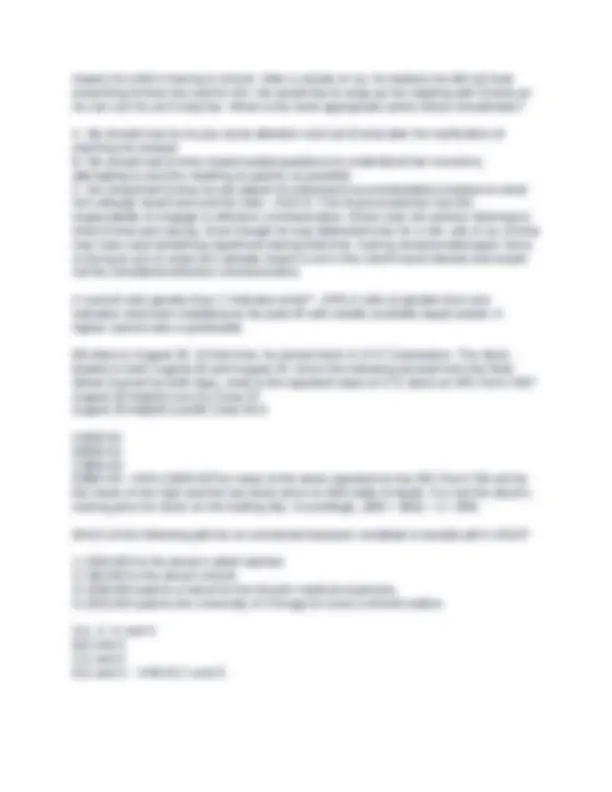
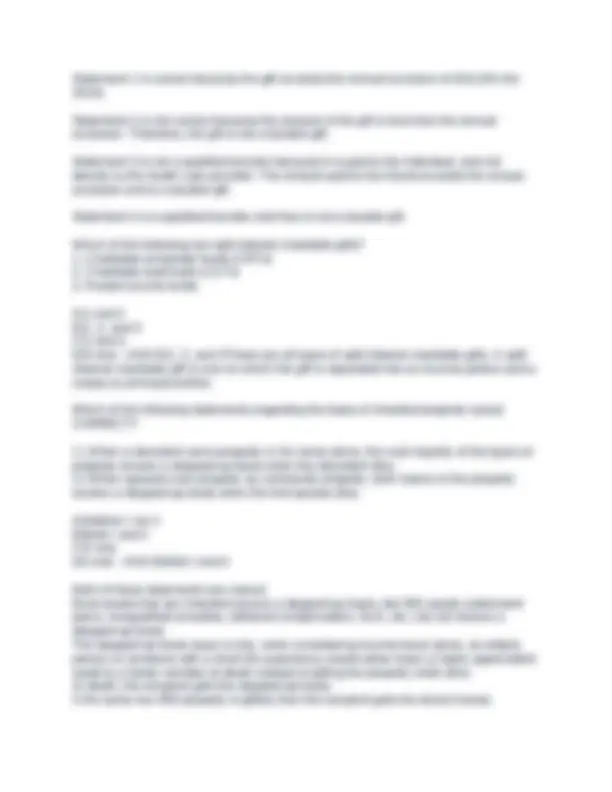
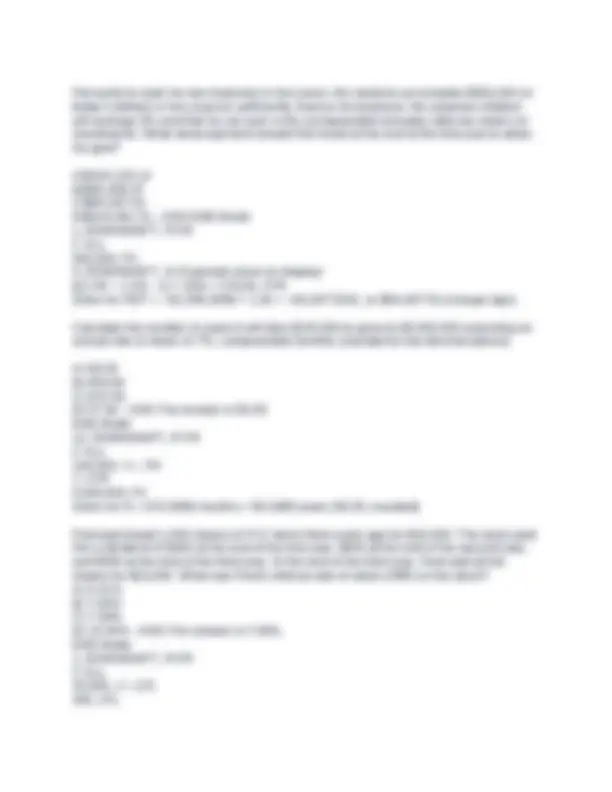
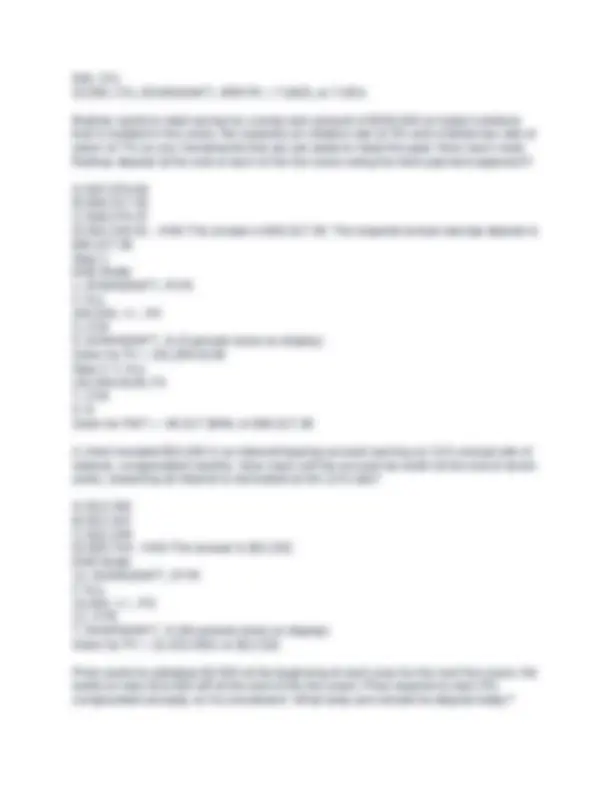
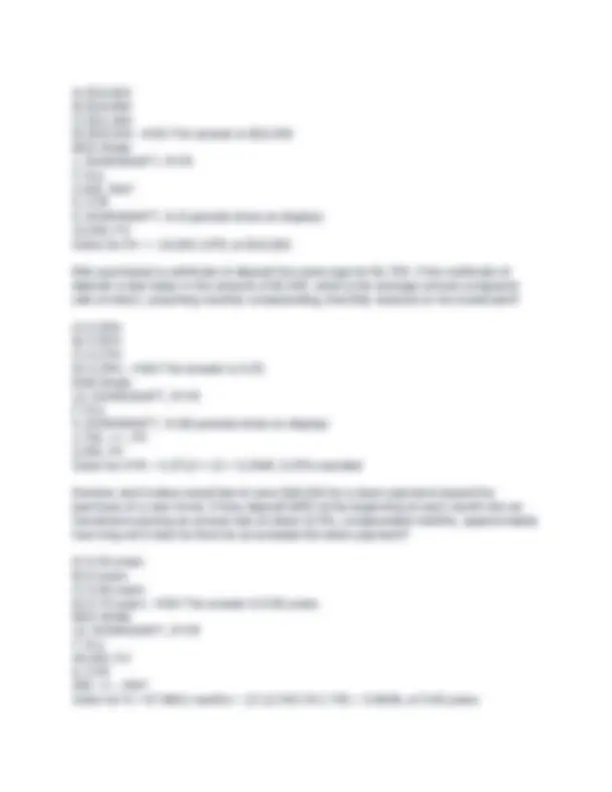
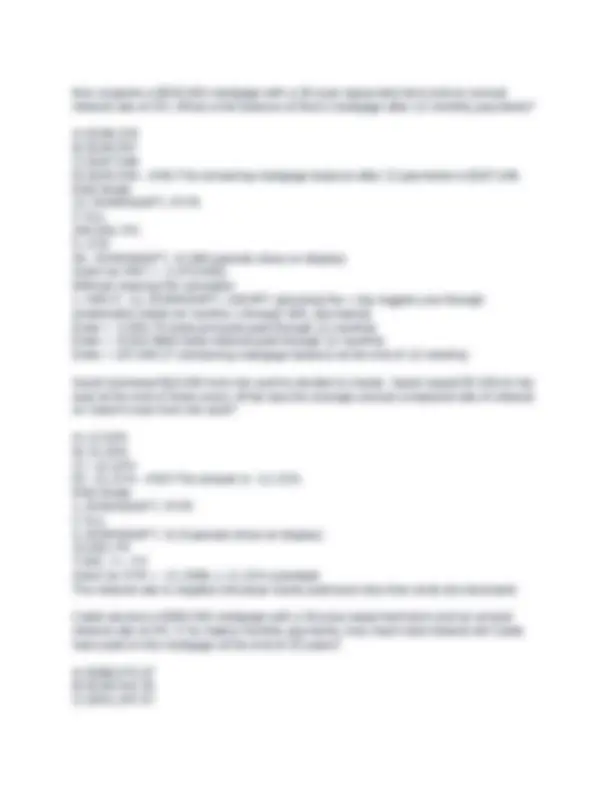
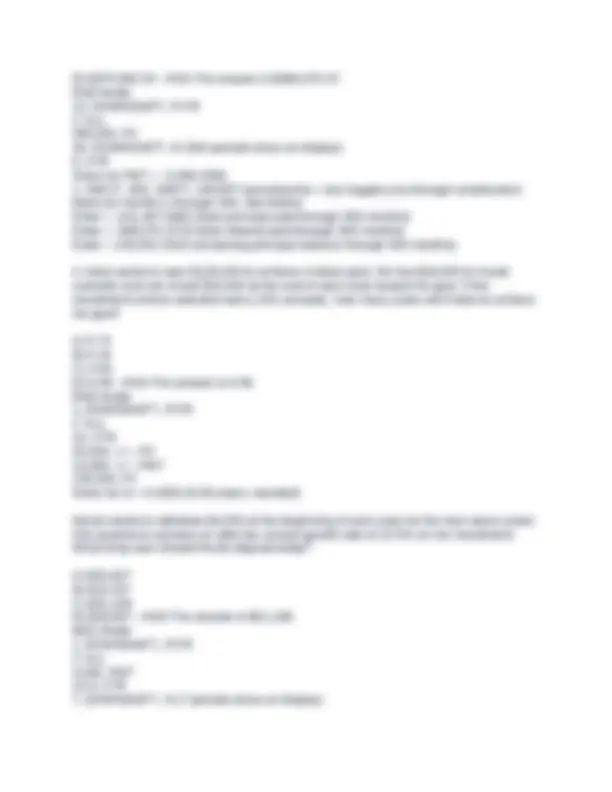
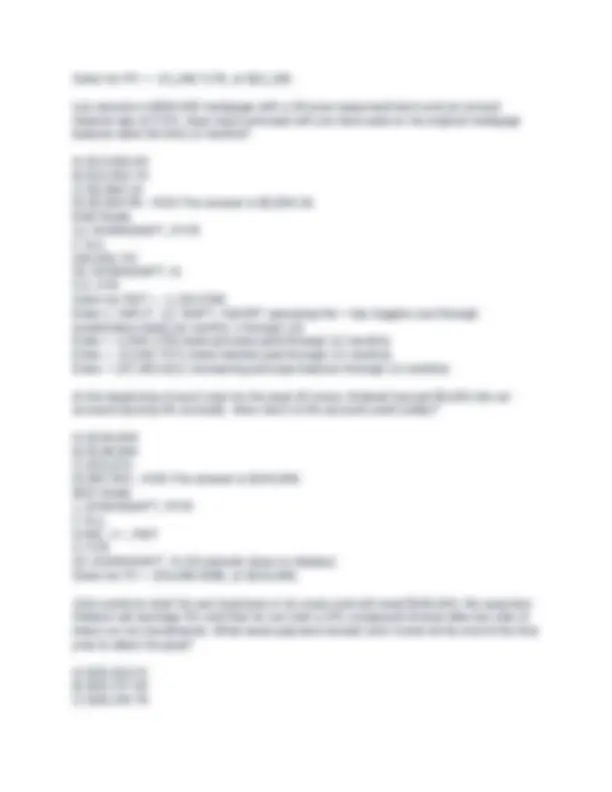



Study with the several resources on Docsity

Earn points by helping other students or get them with a premium plan


Prepare for your exams
Study with the several resources on Docsity

Earn points to download
Earn points by helping other students or get them with a premium plan
Community
Ask the community for help and clear up your study doubts
Discover the best universities in your country according to Docsity users
Free resources
Download our free guides on studying techniques, anxiety management strategies, and thesis advice from Docsity tutors
CFP PRACTICE TEST QUESTIONS AND ANSWERS
Typology: Exams
1 / 280

This page cannot be seen from the preview
Don't miss anything!





























































































Which of the following activities would be appropriate if you were establishing and defining the client-planner relationship or gathering information necessary to fulfill the engagement? Collecting personal financial information Inquiring about the number of dependents Inquiring about the age or dates of birth of dependents Determining which stocks to purchase for the client's investment portfolio A) I, II, and III B) I, II, III, and IV C) I and II D) II and III - ANS-The correct answer is I, II, and III. Establishing and defining the client- planner relationship does not include determining which stocks or investments to purchase. This occurs in the fourth phase of the financial planning process, developing the recommendations. Which of the following CFP® certificants would likely be considered to be engaged in financial planning or the material elements of financial planning? Lance, who reviews a life insurance sales brochure with his client, Arthur, and completes a variable life insurance application Nadia, who conducts comprehensive data gathering regarding Jason's investments, life insurance, retirement plans, wills, and trusts and makes recommendations for him A) Both I and II B) Neither I nor II C) II only D) I only - ANS-The correct answer is II only. Because Nadia's services involve several of the financial planning subject areas and she is involved in the elements of financial planning, she is likely providing financial planning. Lance's service to Arthur is limited, and the engagement would likely not be considered financial planning.
According to CFP Board Code of Ethics, Connor, a CFP® professional, is responsible for which of the following? Acting in the client's best interests Avoiding or disclosing and managing conflicts of interest Acting with honesty, integrity, competence, and diligence Maintaining the confidentiality and protect the privacy of client information A) I and II B) II and IV C) I, III, and IV D) I, II, III, and IV - ANS-The correct answer is I, II, III, and IV. A CFP® professional must Act with honesty, integrity, competence, and diligence. Act in the client's best interests. Exercise due care. Avoid or disclose and manage conflicts of interest. Maintain the confidentiality and protect the privacy of client information. Act in a manner that reflects positively on the financial planning profession and CFP® certification. Amanda, a CFP® professional, is enjoying an afternoon at her son's school playground when she is approached by Tracy, a fellow parent and teacher at a local elementary school. Their conversation covers specifics about Tracy's personal and financial situation, with emphasis on a recommended investment strategy for her 403(b) account. Amanda is aware that she is providing Financial Advice to Tracy. Identify the correct application of rules from the Code and Standards based on Amanda and Tracy's interaction. A) Tracy is technically not a client and the conversation is occurring outside Amanda's office, therefore, neither the Fiduciary requirements nor Code of Ethics applies. B) Since only Financial Advice is occurring, Amanda must uphold only her Fiduciary Duty. C) Although only Financial Advice has been determined, Amanda must uphold her Fiduciary Duty and must follow the Code of Ethics. D) While not necessary, due to - ANS-The correct answer is although only Financial Advice has been determined, Amanda must uphold her Fiduciary Duty and must follow the Code of Ethics. As a CFP® professional, Amanda is obligated to uphold the Code of Ethics. In addition, since Financial Advice is occurring, Amanda must act as a Fiduciary, in the best interest of Tracy. The introduction of the Code and Standards specifically states "The Code of Ethics applies at all times, and sets forth principles that guide the behavior of CFP® professionals, with elaboration provided in the Standards."
Short-term goals, such as protection and maintenance of current lifestyle C) Long-term goals, such as investing for retirement D) Short-term goals, such as saving for a down payment on a home - ANS-The correct answer is long-term goals, such as investing for retirement. Maxine is in the conservation/protection phase of the financial life cycle. As such, her goals are likely longer-term goals, such as investing to provide for future retirement income. In the accumulation phase of the financial life cycle, clients have only limited discretionary income and, as a result, they are likely to focus on short-term, cost-of-living goals. Finally, in the distribution/gifting phase, estate planning and capital preservation are usually most important. Blanca, a CFP® professional, has recently entered into a financial planning engagement with Simon. As his financial planner, which of the following are Blanca's roles? Analyzing Simon's current financial status Assisting Simon in implementing the financial plan Helping Simon identify financial goals and objectives A) I only B) II and III C) I and III D) I, II, and III - ANS-The correct answer is I, II, and III. The financial planner is responsible for analyzing clients' financial status, assisting clients in implementing their financial plans, and making recommendations based on the client's goals and objectives. Candice has referred Rochelle, a CFP® professional, to her brother, Nelson. In their initial meeting, Rochelle explains how she can help Nelson develop a comprehensive financial plan. Which of the following would be Rochelle's roles in a client-planner relationship with Nelson? Assisting Nelson in identifying his goals Analyzing Nelson's current financial status Recommending strategies that will meet Nelson's business goals Providing documentation Rochelle needs to complete the financial plan A) I, III, and IV B) I and II C) II and IV D)
I, II, and III - ANS-The correct answer is I, II, and III. Rochelle is responsible for helping Nelson with identifying his goals and making recommendations based on those goals. She is also responsible for analyzing Nelson's current financial status. Nelson has the duty to provide documentation Rochelle needs to complete the financial plan. In 2012, the average cost of a new home in Oakville was $150,000. In 2014 the average cost rose to $210,000. Due to an economic downturn in 2017, the average cost of a new home fell to $185,000, and the reaction to the decreased cost was positive, even though the new average cost was higher than the 2012 average cost of a new home. This behavior is known as A) herding. B) anchoring. C) confirmation bias. D) mental accounting. - ANS-The correct answer is anchoring. When the average cost of a new home rose in 2014 to $210,000, home buyers reset their psychological anchors to that cost. As the price declined in 2017 to $185,000, the reaction was positive because it was considered in light of the higher 2014 price. Recently, Fallon, an avid shopper, has heard from her friends that an investment in Shoes-2-You stock was a wise idea because the shoes sold are very stylish. Even though Fallon's financial planner has advised her that investing in this stock is a poor decision, she invests in it anyway. Her brother, Stanley, congratulates her on her investment because he feels it is a wise investment. Stanley considers himself to be an expert in investments. Unfortunately, he considers his expertise to be much greater than it actually is. In the past, Stanley has taken credit for any investment decisions that have positive returns but blames the economy when an investment does poorly. Considering Fallon's and Stanley's behavior, which of the following statements is CORRECT? A) Fallon's behavior is an example of overconfidence; Stanley's behavior is representative of anchoring. B) Fallon's behavior is an example of mental accounting; - ANS-The correct answer is that Fallon's behavior is an example of confirmation bias; Stanley's behavior is representative of overconfidence. Confirmation bias is paying attention to information that supports a preconceived opinion and poorly made decision, while disregarding accurate, unsupportive information. Overconfidence tends to make Stanley believe his level of ability is much higher than what it is. Anchoring is making irrational decisions based on information that should have no influence on the decision at hand. Mental accounting is putting money into separate "accounts" based on the function of these accounts.
Wendy should consider the trip as one of Chrissy's goals and explain how such a goal would impact her overall financial plan. Wendy should share her opinion with Chrissy and persuade her to abandon this as one of her goals. Because Wendy, as Chrissy's financial planner, does not feel taking the trip is a wise financial decision, she should not inclu - ANS-The correct answer is I and II. Wendy should respect Chrissy's wishes and understand that such a trip is part of a family tradition. She should consider the trip as one of Chrissy's goals; however, she should also let her know how such a goal would impact Chrissy's overall financial plan. Wendy should not share her opinion with Chrissy or try to persuade her to abandon it as one of her goals. In his financial planning practice, Frank allows his clients' goals and values to drive his relationships with them. He sees himself as a consultant. Frank's approach to financial counseling is known as A) the economic and resource approach. B) the strategic management approach. C) the classical economics approach. D) the cognitive-behavioral approach. - ANS-The correct answer is the strategic management approach. In this approach, the client's goals and values drive the client- planner relationship and the planner serves as a consultant. In the classical economics approach, planners attempt to achieve better financial outcomes by increasing financial resources or reducing expenditures. The cognitive-behavioral approach believes a client's attitudes, beliefs, and values influence their behavior and tries to replace negative beliefs with positive attitudes that should result in better financial results. Which of these statements regarding the classical economics approach to financial counseling is CORRECT? This approach features the use of a SWOT analysis. This approach is based on the use of psychoanalytic theory such as Freudian or Gestalt theory. Clients choose among alternatives based on objectively defined cost-benefit and risk- return tradeoffs. This approach believes that increasing financial resources or reducing financial expenditures results in improved financial outcomes. A) I and III B) II, III, and IV C) III and IV D)
I and IV - ANS-The correct answer is III and IV. Statement I is incorrect; the strategic management approach features the use of a SWOT analysis. Statement II is incorrect; the financial counseling approach that is based on the use of psychoanalytic theory such as Freudian or Gestalt theory is the psychoanalytic approach. Which of the following statements regarding open-ended and closed-ended questions is CORRECT? Planners should use as many open-ended questions as possible when developing client goals and expectations. Closed-ended questions facilitate effective communication between the client and planner because they require the client to answer in her own words. A) II only B) Neither I nor II C) I only D) Both I and II - ANS-The correct answer is I only. Planners should use as many open- ended questions as possible when developing client goals and expectations. These types of questions require clients to answer in their own words. Open-ended questions facilitate effective communication between clients and planners. Statement II is incorrect. Closed-ended elicit "yes" or "no" answers, and this can restrict communication. Bernie is meeting with his clients, Mike and Alyssa, to define their goals. Mike tells Bernie that one of his goals is purchasing a hunting camp in two years and Alyssa shakes her head. What is the best action for Bernie to take next? A) Ask Alyssa if the camp is a mutually agreed-upon goal. B) Ask Mike and Alyssa if they have any other goals. C) Get more details regarding the purchase of the camp. D) Recommend how Mike and Alyssa can pay for the camp. - ANS-The correct answer is ask Alyssa if the camp if a mutually agreed-upon goal. Alyssa's body language (shaking her head) may express that she does not agree with this goal. Therefore, Bernie should clarify whether or not she is on board with Mike's idea. If Alyssa is agreeable, Bernie should then get more details regarding the purchase of the camp. Bernie should not move on to other goals before Mike and Alyssa are in agreement regarding this particular one. Lastly, this is not the time to make recommendations without comprehensive information. Which of the following statements regarding interpersonal communication between financial planners and their clients are CORRECT?
I, III, and IV - ANS-The correct answer is III and IV. A statement of financial position, also known as a personal balance sheet or net worth statement, provides a snapshot of the client's net worth at any given point in time, most often at the end of a calendar year. Which of the following statements regarding a financial planner's analysis of a client's cash flow statement is CORRECT? The analysis of the client's cash flow statement can help the planner determine whether the client is living within his financial means. The analysis of the client's cash flow statement helps determine the client's net worth, or total cash surplus, by tracking cash inflows and outflows over a period of time. Typically, the financial planner will encourage the client to reduce the variable expenses reported on the cash flow statement. A) I and II B) I and III C) II only D) I, II, and III - ANS-The correct answer is I and III. Statement II is incorrect. The analysis of the client's cash flow statement helps determine the client's savings level, or total cash surplus, by tracking cash inflows and outflows over a period of time. Net worth is determined in a statement of financial position. You have gathered the following information from Edgar's financial statements: Net income$75, Gross income$110, Total assets$190, Total debt$45, Consumer debt$20, Based on this information, which of the following statements is CORRECT? Edgar's total debt ratio exceeds the generally recommended maximum. Edgar's consumer debt ratio exceeds the generally recommended maximum. A) II only B) I only C) Both I and II D) Neither I nor II - ANS-The correct answer is Both I and II. It is generally recommended that total debts do not exceed 36% of gross income. Edgar's total debt ratio is 40.9%,
greater than the 36% maximum ($45,000 / $110,000 = 40.9%). The consumer debt ratio is the ratio of consumer debt payments to net income. Edgar's consumer debt ratio is 26.67%, which exceeds the generally recommended maximum of 20% ($20,000 / $75,000 = 26.67%) Blake and Sarah have a monthly mortgage payments of $850 (principal, interest, taxes, and insurance [PITI]) on a mortgage balance of $95,000 on their home. They have an auto loan balance of $5,000, with monthly payments of $250. Additionally, they have a credit card balance of $2,000, on which they pay $225 each month. Blake and Sarah's net income for the past year was $35,000. Their gross income was $48,000. Are Blake and Sarah using excessive amounts of debt? A) Yes, because monthly house payments (PITI) are 28% of net income. B) No, because monthly house payments (PITI) are only 38% of net income and total monthly debt payments are only 33% of gross income. C) Yes, because total monthly debt payments are more than 28% of gross income. D) No, because monthly house payments (PITI) are less than 28% of gross income and total monthly debt payments are only 33% of gross income. - ANS-The correct answer is no, because monthly house payments (PITI) are less than 28% of gross income and total monthly debt payments are only 33% of gross income. Blake and Sarah are not using excessive amounts of debt. Both ratios should be calculated using gross income. Which of the following are considered fixed cash outflows? Clothing expenses Mortgage payments Insurance premiums Auto loan payments A) II and IV B) II only C) I, III, and IV D) II, III, and IV - ANS-The correct answer is II, III, and IV. Clothing expenses are a variable outflow because they typically do not occur on a regular basis and the amount tends to vary. The other choices represent fixed outflows because they tend to occur regularly and the amount is more predictable. Peter, age 35, has requested your expertise in developing a college funding plan for his five-year-old daughter, Brooke. He has presented you with the following information.
I, II, III, and IV B) I, III, and IV C) I and III D) II and IV - ANS-The correct answer is I and III. Macy can use the money she saves by limiting the number of lattes she purchases to increase her savings. Using an overdraft feature on debit cards may tempt her to spend money she does not have available in her account. Increasing insurance deductibles decreases premiums, which is a good savings strategy. If credit cards are used, they should be paid off in full at the end of each month. Over the years, Quinn has made timely payments on four of his credit card accounts, all which have balances near the available credit limits. He did pay off a fifth credit card account, which he had for 20 years, and immediately closed it. Which of the following statements regarding Quinn's credit score is CORRECT? By immediately closing his long-standing account when it was paid off, Quinn likely decreased his credit score. Having four credit card account balances near their available credit limits will in all likelihood adversely affect Quinn's credit score. A) Both I and II B) I only C) Neither I nor II D) II only - ANS-The correct answer is both I and II. Immediately closing long-standing accounts will likely decrease Quinn's credit score. Keeping account balances near the available credit limit has a negative effect. Craig is refinancing his current 7.5% 30-year fixed-rate mortgage for $150,000 into a new 5.75% 30-year mortgage for $150,000. How much is his new monthly payment and how much per month will he save on this payment? A) New payment = $1,048.82, savings = $196. B) New payment = $875.82, savings = $341. C) New payment = $1,048.82, savings = $173. D) New payment = $875.36, savings = $173.46 - ANS-The correct answer is new payment = $875.36, savings = $173.46. END Mode 12, DOWNSHIFT, P/YR
Old payment: 150000, PV 30, DOWNSHIFT, N = 360 7.5, I/YR Solve for PMT = −1,048.82 or $1,048. END Mode 12, DOWNSHIFT, P/YR DOWNSHIFT, C ALL New payment: 150000,PV 30, DOWNSHIFT, N = 360 5.75, I/YR Solve for PMT = −875.36 or $875. Savings = $1,048.82 − $875.36 = $173. Which of the following actions would most likely help an individual improve their credit score? A) Take advantage of several offers for new credit cards. B) Close a long-standing credit card account that has been paid off. C) Make the minimum payment on time each month. D) Maintain account balances near the credit limit. - ANS-The correct answer is to make the minimum payment on time each month. Although making a minimum payment on a credit card will mean an individual will pay significant interest over the years, it shows creditworthiness and, over time, would increase a credit score. Which of the following statements regarding the decision to buy or lease a home are CORRECT? The itemized tax deduction for mortgage interest is a benefit of home ownership. A client who will be residing in the home for a short period of time should lease the home. The lower the marginal income tax bracket, the greater the advantage of owning a home. Generally, more costs are associated with buying a home, especially if this arrangement is short term. A) I, II, and IV B) I only C) I and II D)
Frank purchased an antique table today for $30,000. Experts advised him the table will increase in value at a rate of 3% annually for the next six years. Approximately how much will the table be worth at the end of the sixth year if his expected return is achieved? A) $34, B) $36, C) $35, D) $35,822 - ANS-The correct answer is $35,822. This is a future value of a single sum calculation. The keystrokes on the HP 10bII/HP 10bII+ are as follows: END Mode 1, DOWNSHIFT, P/YR DOWNSHIFT, C ALL 30000, +/-, PV 3, I/YR 6, DOWNSHIFT, N Solve for FV = 35,821.5689, or approximately $35,822. Zach expects to receive $20,000 in eight years from his uncle Bradley. How much is this worth in today's dollars assuming a 6% after-tax interest rate, compounded annually? A) $14, B) $10, C) $12, D) $12,548 - ANS-The correct answer is $12,548. This requires a present value of a single sum calculation. The keystrokes on the HP 10bII/HP 10bII+ are as follows: END Mode 1, DOWNSHIFT, P/YR DOWNSHIFT, C ALL 20000, FV 6, I/YR 8, DOWNSHIFT, N Solve for PV = −12,548.2474, or $12,548. Charley invested $100,000 12 years ago. Today, it is valued at $250,000. What is the rate of return for Charley's investment? A) 7.93% B) 9.60%
7.35% - ANS-The correct answer is 7.93%. This requires an interest rate calculation. The keystrokes on the HP 10bII/HP 10bII+ are as follows: END Mode 1, DOWNSHIFT, P/YR DOWNSHIFT, C ALL 100000, +/-, PV 250000, FV 12, DOWNSHIFT, N Solve for I/YR = 7.9348, or 7.93%. Annie deposits $2,500 into an account earning an annual interest rate of 6.25% compounded monthly. Assuming she makes no withdrawals or additions to this account, approximately how many years will it take for Annie to have $5,000 in her account? A) 11.43 years B) 11.12 years C) 12.13 years D) 10.25 years - ANS-The correct answer is 11.12 years. This is a number of periods calculation. The keystrokes on the HP 10bII/HP 10bII+ are as follows: END Mode 12, DOWNSHIFT, P/YR DOWNSHIFT, C ALL 2500, +/-, PV 5000, FV 6.25, I/YR Solve for N = 133.4305 months ÷ 12 = 11.1192, or 11.12 years. Phil secures a $350,000, 15-year mortgage with an annual interest rate of 5.5%. What will be the unpaid principal balance on Phil's mortgage at the end of 10 years? A) $149,718. B) $145,238. C) $168,128. D) $200,281.78 - ANS-The correct answer is $149,718.22. The unpaid principal balance on Phil's mortgage at the end of 10 years will be $104,761.78. The keystrokes on the HP 10bII/HP 10bII+ are as follows: END mode
Solve for I/YR = 3.41% Bryan wants to open a photography studio in four years. To do so, he needs to accumulate $175,000 (in today's dollars) to adequately finance this venture. He assumes he can earn an 8% compound annual after-tax rate of return on investment and inflation will average 3.5%. What will be Bryan's serial payment at the end of the third year? A) $43,917. B) $40,997. C) $42,432. D) $45,455.08 - ANS-The correct answer is $45,455.08. END mode FV= 175,000i= 4.3478 [(1.08 ÷ 1.035) − 1] × 100n= 4PV= 0PMTOA= (40,997.8820) × 1.035 = 42,432.8078 (change sign) 42,432.8078 × 1.035 = 43,917. 43,917.9561 × 1.035 = $45,455. John would like to purchase his friend's action figure collection in eight years for $12,000. His father will give him $2,000 toward the purchase of the collection at that time. John wants to save monthly for the balance of the purchase price. What is the approximate required monthly payment at the beginning of each month to accumulate the $12,000, including his father's gift, at an assumed interest rate of 5%? A) $101. B) $84. C) $101. D) $84.93 - ANS-The correct answer is $84.58. This requires an annuity due calculation. The amount to be funded is $10,000 ($12,000 - $2,000). The keystrokes on the HP 10bII/HP 10bII+ are as follows: BEG mode 12, DOWNSHIFT, P/YR DOWNSHIFT, C ALL 10000, FV 5, I/YR 8, DOWNSHIFT, N = 96
Solve for PMT = −84.5801, or $84.58. You've determined the net present value (NPV) of your client's investment to be $32,500. If your client's required rate of return is 8%, which of the following is most likely to be the investment's internal rate of return (IRR)? A) 7% B) 3% C) 0% D) 9% - ANS-The correct answer is 9%. If the net present value (NPV) of the investment is a positive number, the investment's IRR must be greater than or equal to the investor's required rate of return. Here, the investor's required rate of return is 8%, so the IRR must be greater than or equal to 8%. Wes is considering investing in a new printing press for his printing business. The purchase price of the printing press is $225,000 and he expects to be able to sell it for $150,000 at the end of five years. During the five-year period, he expects the equipment to increase her annual cash flows by $45,000 (year 1), $32,000 (year 2), $24,000 (year 3), $16,000 (year 4), and $10,000 (year 5). If his opportunity cost is 7%, what is the net present value (NPV) of this investment? A) −$16,192. B) -$16,248. C) -$9,118. D) -$22,998.56 - ANS-The correct answer is -$9,118.62. The keystrokes on the HP 10bII/HP 10bII+ are as follows: 225,000 +/- CFj (year 0); 45,000 CFj (year 1); 32, CFj (year 2); 24,000 CFj (year 3); 16,000 CFj (year 4); 160,000 CFj (year 5; final annual cash flow of $10,000 plus the anticipated sales price of $150,000); 7 I/YR [DOWNSHIFT] NPV = -$9,118.6248, or -$9,118.62. Johanna is considering purchasing a greenhouse for use in her business that will cost $25,000. She anticipates selling this machine at the end of five years for $7,500. The machine is projected to produce the following cash flows: End of year 1: $ End of year 2: $ End of year 3: $1, End of year 4: $2, End of year 5: $4, Calculate the net present value (NPV) of purchasing the machine if Johanna's opportunity cost is 10%. A) −$14,413. B) -$19,070. C) −$2,377. D) +$1,700.06 - ANS-The correct answer is −$14,413.11. Keystrokes on the HP 10bII/HP 10bII+ are as follows: 25000, +/−, CFj 500, CFj 750, CFj